#so that in particular is primarily used for slang now
Text
Another random headcanon for the day! This time, it's about Angelic and Demonic! (the languages)
For Angelic, it's actually not spoken as frequently in Heaven as it used to be, these days. This is partly because it's not a language that a lot of other beings are actually able to speak, which made communication difficult when Heaven began to selectively open their gates for other species and such to visit.
Instead, on top of speaking Angelic, young angels are now also taught Common-tongue much more seriously as well. It's Common-tongue that is now used more frequently overall in the realm...though it's also not odd for angels to learn even more languages on top of those two-- for the most part, these extra languages are those from the Mortal Realm, one of the nearby fae realms, or Elvish. Even Demonic isn't too rare these days, though it tends to be the angels that travel commonly that choose to learn that.
As a language though, Angelic is extremely harsh-sounding, for the most part. For a lot of beings, it can physically hurt to listen to for very long, which is another reason why it isn't really "sustainable" for them to speak it as exclusively as they used to. I think of it as like...Angelic is supposed to sound kind of unsettling. A bit like a warning, or bordering on threatening in a way? Also just very authoritative, overall.
For Demonic, on the other hand, I always think of it as being a very entrancing and alluring sort of language, made specifically for tempting others into things (like contracts, but not always), essentially. One that-- again, opposing Angelic-- is supposed to be very easy overall for other species to speak, and to listen to.
Because of how easy it is to speak and learn, Demonic is still by far the most commonly spoken language in Hell and other places, (like the realm of the reapers, Tenimus, for example) with demons and those living in Hell speaking it far more typically as their only language. Common-tongue is still the second-most spoken, though it's really close between that and fae languages.
Demonic was also based pretty heavily on Brinnelan, or the Ancient tongue (because that's what Heaven and Hell grew up speaking in Pirodet, before coming into their realm bodies as they got older). At least in sound-- their alphabets are vastly different. Angelic, on the other hand, sounds vastly different, but their alphabet is based heavily on that of the Brinnelan language!
#[Worldbuilding]#I can't remember why I started thinking about this but here it is!#Yeah though aside from a few words Angelic is just...not kind to non-angels#Off the top of my head I can only think of a few species that are able to listen to it without it hurting#and even fewer that are capable of speaking it 'properly'#There /was/ an adapted Angelic for a while when Heaven first started opening up their gates to other realms#since it was easier for the Angels to do that at first than it was to teach /everyone/ a new language (common-tongue)#and that's easier for others to speak and learn but still kinda hurt to listen to for any longer periods of time#so that in particular is primarily used for slang now#Demonic on the other hand hasn't changed much at all over the ages-- sort of an 'if it ain't broke don't fix it' sort of thing#but they /do/ have a lot of different dialects where Angelic doesn't have any
6 notes
·
View notes
Text
Slang, as a rule, not only signifies concepts and things but also, and first of all, the subjective behavior, the feelings, habits, oddities, jokes, tricks, collusions, experiences, and resentments which are peculiar to the group and differentiate it from any other; it alludes to the secret life of the group and strengthens this collective life. It affords a particular delight because only the man who belongs to the group can understand it, and because in using it he immerses himself in this incommunicable hermetic life. Each time he uses the slang of the group, he affirms and reinforces his communion with the group and, in one sense, the giving up of his own personality to the group. The word becomes a kind of magic and operative sign of the unity of the group, and of its difference from ordinary mankind. Then, indivisibly from its function as direct sign, the word is essentially a reverse or inverted sign of the subjectivity, self-love, and pride of the group.
That is why slang cannot really be translated into ordinary language without losing its meaning and flavor. More than an object of thought, it means the overtones that accompany this object in terms of human and social subjectivity. The human despair and abjection with which certain abject writers have to saturate the world of things could not be expressed except in their slang.
Now, if it is true that the essence of language is to manifest thought and objects of thought, it is difficult not to conclude that the various slangs of which I spoke involve a kind of perversion of the function of language.
No doubt an element of reverse or inverted signification is inseparable from the direct signification of the words. But genuine language, while expressive of the group’s subjectivity, gives unquestionable prevalence to objectivity, and direct sign, and to the universality of direct, intellectual meaning; and then the secondary function of language, i.e., the intention of expressing subjectivity, remains itself open, it is oriented toward a communication of the collective self, which tends to make itself sincerely known to others. The risk of impurity of which I am speaking materializes when this intention of expressing subjectivity becomes oriented toward the self-assertion of the group in a closed, aristocratic, or resentful manner, and as against all other groups.
The primary and the secondary functions of language are both human. Language attains complete freedom, and the excellence of its own nature, when these two functions are perfectly fused. The subjective function, however, is, as I have said, secondary. Furthermore it remains, as a rule, in an inchoate and unsatisfactory condition, because our words are primarily destined to designate material and external things. As a result, in their secondary function itself they signify the subjectivity of the social group rather than that of the individual person, and they do so in a more or less awkward and rough manner, which depends on the particular history and accidental experiences of the group. Let me say, therefore, that if Angels used words, it is only in the language of Angels that the two functions of which I am speaking would be really and perfectly fused. It is only in the tongue of Angels that language could attain complete freedom and the excellence of its own nature.
But Angels use no words.
Poets, in mankind, desperately endeavor to achieve a certain similarity of the language of Angels, or of perfect language, capable of expressing things and the self together in one and the same breath. Thus, what birds realize by music only, man can somewhat realize by poetry, and his music has also an intelligible significance, a spiritual meaning.
Jacques Maritain, Language and the Theory of Sign
19 notes
·
View notes
Text
Ordinarily, today would be the day I would show off example cards to help guide those requiring additional inspiration. Unfortunately, I don’t feel that that makes much sense for this week. While I am more than okay with receiving multiple designs operating on similar axes, having a sample design possibly intersect with someone’s submission feels uniquely awful enough that I’ve elected to take a different approach. Today I intend to talk about mechanic design, the philosophy behind my word choices, and how I might approach designing around each of them:
There is a phrase I used in the main post that I feel is worth digging a bit deeper into, specifically “could reasonably inform the identity of a premier set.” While this may suggest some great level of mechanic density, I feel that isn’t quite the whole of it. You don’t need a high concentration of cards with a certain mechanic to have an impact on a draft environment: Just look at Tempest, a set which contains a rather mammoth 350 cards, only twelve of which feature the buyback mechanic. Despite being only 3.5% of the entire set, the cards show up frequently enough and have enough of an impact on the board that cards like Rats of Rath were created specifically to provide counterplay to their otherwise stifling presence. So long as your mechanic makes a baseline amount of sense as a mechanic (I.E. It contributes something to the hypothetical environment it is in, and can be used on more than like, three cards) then you’re probably doing fine. Just make sure to at least briefly consider the hypothetical environment these cards might exist in. I realize you’re only submitting one card, but it helps to have a vague idea of where this card might exist in a space it was designed for, rather than strictly in a Fair-shaped vacuum.
As for the mechanics themselves, they were selected primarily for flexibility. I know Magic generally opts for stronger, more evocative names for its mechanics, but for the purposes of this contest that seemed suboptimal. If I asked y’all to design, say, Quadruple strike, I imagine I’d get a lot of very similar submissions. So instead we are left with four words, each capable of being A Thing or An Action (or, as the experts call them, Nouns and Verbs), and each carrying at least a degree of resonance with them, ideally not the kind of resonance that already has heavy mechanical connotations in Magic. This assemblage of words was actually surprisingly difficult to cultivate, so I made sure to give y’all plenty of options, and hopefully you will find something worthwhile in at least one of them.
Anyway, on to the mechanics themselves:
Brew: Nounwise, it is a concoction, a potion, an ale. Some kind of beverage, possibly magical? Brew also has the extant Magic connotation of Creative Deck Construction, but that felt slang-y enough that I didn’t consider it too overbearing, though I would not discount it as a flavor direction to head in. Verb-wise, it generally refers to the construction of said beverages and creative blends. The strengths of this name, I think, definitely lie in its relatively concrete flavor hook. It may be somewhat inflexible, but magical potions are, I feel, not an especially deeply mined mechanical vein, and there's possibly a decent well of space to explore there.
Focus: Focus-the-verb is very much, well, focused. A lot of heavily-directed thought or energy or attention, given to a certain object or action or point. Focus as a noun is also pertinent as a sort of ritualistic object to aid in the conduction of magics, or as a particular pursuit. There are many angles one could approach this from, but a key thread to all of these definitions is this sort of concentration. Fortunately, there are enough things one can concentrate on, and ways one can concentrate, that I don’t think you need to be especially subversive with this one. This is definitely among the strongest words in the pool for this reason, I think.
Order: And now we come to the big one. Order stuck out to me because it can go in so many different directions, so much so that I didn’t especially care that the word itself felt somewhat white-mana-aligned. Certainly, they do all generally involve some amount of structure and hierarchy, but orders can range from instructions to organizational methods to religious factions. Heck, there’s even some math in there. Not sure how much math one could feasibly fit in a fantasy card game, but, well, Quandrix exists, so maybe you could do something with that. If I were to construct a card with Order, and I craved self-imposed restrictions beyond the scope of the prompt (as I often do), I would definitely try to figure out how to make an Order which makes sense outside of white. By no means are you required to do this, but if you are looking for some further constraint-based direction, that’s probably what I would go for.
Sketch: And then, at last, we come to the wild card. I’ll be honest, if I were forced to remove a word from this list, I would probably axe this one, as I had pretty much no idea what people would do with it going into this contest, but I figured I’d leave it anyway just in case someone wanted a bit of a challenge. It definitely strays a bit further from what we’ve seen from Magic, generally, but it does have a very strong flavor leaning, and extrapolating that into an Actual Magic Mechanic strikes me as an interesting challenge. Definitionally, it refers to rough, unfinished drawings, and the creation thereof. I would probably hone in on the idea of something which has not yet been fully constructed, though I have seen others play around in the Discord with designs more focused on the actual act of writing something down, which strikes me as an equally interesting and valid vein of design, and I’m quite excited to see where y’all might go with it.
I hope this vague ramble helped to shine at least a little light on my thought processes behind the curtain, and possibly even gave you some potential perspective on the mechanics that you may not have yet considered. Regardless, I wish you the best of luck in navigating this admittedly arduous contest.
- @starch255
7 notes
·
View notes
Text
Samsung Galaxy AI ASR: Always Listening, Always Responding

Samsung Galaxy AI ASR and TTS
Reporters visit Samsung Research Centres worldwide to find out how Galaxy AI is helping more users reach their full potential as Samsung keeps leading the way in premium mobile AI experiences. With 16 languages now supported by Galaxy AI, more individuals can learn more languages even when they’re not online.
This is made possible by on-device translation included in services like Live Translate, Interpreter, Note Assist, and Browsing Assistance. However, what is involved in developing AI languages? This article looks at the difficulties it encountered when using mobile AI and how they resolved them. To find out where one starts teaching AI to speak a new language, let first travel to Indonesia.
As per the staff at Samsung R&D Institute Indonesia (SRIN), setting targets is the first stage. Excellent AI starts with relevant and high-quality data. Junaidillah Fadlil, head of AI at SRIN, says, “Every language demands a different way to process this, forcing us to dive deep to understand the linguistic needs and the specific national conditions.” Galaxy AI now supports Bahasa Indonesia, thanks to his team. Insight and science must guide local language development, so the first step in adding languages to Galaxy AI is for us to plan what information is necessary and can ethically and legally obtain.”
Text-to-speech (TTS), neural machine translation (NMT), and automated speech recognition (ASR) are the three main tasks carried out by Galaxy AI capabilities like Live Translate. Every operation requires a different set of data.
For example, ASR requires large-scale speech recordings in multiple settings, each accompanied by a precise text transcription. varied settings can be explained by varied quantities of background noise. The team’s ASR lead, Muchlisin Adi Saputra, says that simply adding noises to recordings is insufficient.
What is Automatic Speech Recognition
Automatic Speech Recognition (ASR). It lets computers translate spoken language into text.
Here’s ASR breakdown:
Automatic: ASR systems transcribe speech from recordings or in real time without manual intervention.
Speech Recognition: The technology analyses audio clips for words.
The recognised words are transformed to text.
ASR is growing more popular and has many uses:
Voice assistants: Like Siri or Alexa, ASR lets you talk to devices.
ASR can transcribe lectures, meetings, and interviews into text.
Closed captioning: ASR generates real-time video and live stream captions.
Interactive voice response (IVR) systems: ASR allows voice responses to automated phone menus.
ASR technology improves accuracy and handles accents and backgrounds.
Apart from the language data but gathered from approved third-party partners, but also need to record our own voices by going into coffee shops or business settings. This enables us to faithfully reproduce distinctive noises from everyday life, such as keyboard clatter and individuals crying out.
It’s also important to take into account how languages are always evolving. “It’s need to stay current with the newest slang and its usage, and we primarily find it on social media,” continues Saputra.
Next, translation training data is needed for NMT. “It’s difficult to translate Bahasa Indonesia,” notes the team’s NMT lead, Muhammad Faisal. They require a large number of translated texts that the AI might consult for new terms, foreign words, proper nouns, and idioms any material that helps AI grasp the context and rules of communication because of its extensive use of implicit and contextual meanings, which depends on social and situational cues.
Then, for TTS, recordings that encompass a variety of voices and tones are needed, along with more context regarding the sounds that particular word parts make in various situations. According to TTS lead Hartis Abdurrahman, “well-made voice recordings could cover all the required phonemes (units of sound in speech) for the AI model and do half the job.” “If a voice actor performed exceptionally well in the previous round, the emphasis switches to improving the AI model to speak particular words clearly.”
Here are a few particular instances of data that is used to teaching AI new languages:
Text and translations: Machine translation requires parallel text data, which presents a sentence or document in both the source and target languages.
Speech transcripts and recordings: AI must also learn a language in spoken form. The AI is able to identify accents and speech patterns thanks to recordings matched with textual transcripts.
Social media data: Social media offers an abundance of colloquial language, slang, and contemporary patterns that help the AI remain abreast of real-world communication patterns.
Essentially, data serves as the AI’s instructor, giving it the knowledge required to understand the nuances of a foreign language and interact with others successfully.
Greater Together
Planning for a large amount of data requires substantial resources, and SRIN collaborated extensively with linguists. “This challenge calls for ingenuity, resourcefulness, and proficiency in machine learning and Bahasa Indonesia,” Fadlil muses. “Samsung’s open collaboration philosophy, combined with our operations scale and AI development history, were key factors in completing the task.”
The SRIN team overcame the challenges of setting data targets and swiftly adopted best practices by collaborating with other Samsung Research centres worldwide. Moreover, cooperation helped to advance culture as well as technology. The SRIN crew developed stronger ties and broadened their awareness of various cultures when they joined their colleagues in Bangalore, India, and observed the local fasting rituals.
The team saw a new relevance in the language expansion project of Galaxy AI. “It’s are especially proud of our accomplishments because this was our first AI project. They plan to continue improving our models and output quality, so this won’t be our last,” Fadlil says in closing. “This expansion respects and incorporates our cultural identities through language, while also reflecting our values of openness.”
It will visit Samsung R&D Institute Jordan in the upcoming episode of The Learning Curve to talk with the group in charge of Galaxy AI’s Arabic language project. Watch to discover how difficult it is to create and train an artificial intelligence model for a language with several dialects.
Read more on Govindhtech.com
0 notes
Text
.
#this is not @ anyone in particular bc i'm seeing it a lot and also i'm not telling anyone they need to stop using it#but it's really weird and kinda uncomfortable for me to see how ''simp'' has caught on as fandom slang#it's generally used innocuously except when it's by some discourse goon bullying someone for an imagined slight#(at least in the fandom where i'm primarily active rn)#but..................its usage as internet slang rose to prominence via the ''manosphere''#it's basically repurposed incel/mra language#and it's jarring af to see chill people using it casually to describe their love for characters or tropes or whatever else#esp bc incel/mra dudes still use it A LOT and it's intended to be an insult to men who regard women as human beings#n*zis use it similarly in their communities to insult cishet abled white guys who care about literally any other demographic#so it's.........it's weird to see it used on here so often now even though the context is different#mbpersonalposttag
4 notes
·
View notes
Note
im curious why people are saying supernatural is jewish like idk if jewish writers makes an inherently jewish story especially when things like following out the christian apocalypse from revelations and showing a real physical g-d who is just some guy i think is super jarring since though christians claim to be against idolatry they seem totally fine showing depictions of gd or whatever i dont get jesus honestly but jews are far more strict and the idea of showing gds appearance is pretty wrong
WOOF okay um. Maybe this is one of those Tone Doesn’t Come Thru Well Online things but to me this is soo fucking rude… I’m half way between John Mulaney we don't have time to unpack all of that & Ben Wyatt wait it’s gonna bother me if I don’t explain why you’re wrong.
This turned into all my thoughts.
So like. First off, it’s all fun and games. We’re all just joking and joshing and projecting here on destiel dot tumblr dot com and Jupernatural is not an exception in a lot of ways. And so when someone shits on what we’re doing here (yes, even unintentionally) what you get is what happened: oh you think you’re funny well I’m about to be hilarious!!! aka I’m gonna do it even more now out of spite specifically because you said not to. Like it really is all jokes but also you know what’s not a joke? Antisemitism in all its forms, even the casual shit! It’s really draining and it builds up in your veins!! Just. Yeah. You saw a lot of people talking about it today in particular because much like other topics of the day, one thing kicks off a whole other turn of events. So like. one misguided comment that’s playfully antisemitic and then one more little one, and then one big/obvious one launched us (Jewish spn fans) into a whole bigger discussion about antisemitism and erasure of Jews in the spn fandom writ large. It’s one thing to be descriptive, offer a headcanon/what if, or employ a certain mode of analysis. It’s another thing to definitively say This Is The Truth, specifically when to do so overrides something else, especially in this case when what’s being overridden is Jews, an ethnoreligious minority. It’s also another thing to talk over Jews. And mind this has been building for days. Not in a bad way just like, it’s been topical for days and then today one big thing pushed it over the edge to us actually posting abt it (partially bc at that point it’s a pattern, which feels like it needs to be addressed). Like, destiel tumblr is small we pretty much all see all the same posts, and then Jewish spn fans… we’re friends, we chat about life? We joke around together, y’know? If you’re being antisemitic (yes, even unintentionally) we’re all gonna hear abt it. It’s how we stay safe or in this case, curate the online exp.
That being said tho projecting on fiction is like fun and even a good thing at times, and def opens up new modes of analysis. But! the other big thing here is that there IS a LOT of evidence for a Jewish reading of spn, in a lot of ways, and particularly if you know what to look for. Like there’s lots of niche Jewish slang (non-Jews just don’t know these things, and that is a reflection primarily of the writers but once you put it in the script it implies things about the characters too of course), the theology of the early seasons (I’ll get to that in a second), main character motivations (hold on), “Moishe Campbell” implying Mary is (and therefore Sam and Dean are) Jewish, etc.
It’s not surprising to me or anything that non-Jews don’t catch anything/everything Jewish about spn but that Jews catch both sides of it, because that’s just how being part of a marginalized group works. You learn about your own stuff AND the dominant culture’s stuff because that’s how you survive (socially, psychologically, literally). Members of the dominant culture don’t need to learn the marginalized one, are never confronted with it, and so they just.. don’t. I don’t even mean that in a normative or accusatory way, that’s just an observation on the state of things. Non-Jews who aren’t part of another marginalized religion, aka expressed xtians and cultural xtians, have a ton of misconceptions about Judaism, for example, “Jesus was Jewish” and not, “Jesus was an asshole of an apostate who made life harder for Jews at the time in a myriad of ways and whose movement has had a lasting negative impact on world Jewry (and other peoples) for the ensuing millenia”. I truly Don’t Have Time right now to get into the varied and intense history of antisemitism in all its forms but. the point I’m making here is that I’m not shocked I need to explain that life experience shapes your worldview?? So if you’re Jewish you’re always gonna be living life through that version of the world and it does impact you?? Same as anything else?? As unwell as they may be, spn writers aren’t exempt from that. Jewish people writing about xtianity are doing so thru a primarily Jewish understanding and vice versa. Jews can (and did!) write about xtian lore but in a Jewish way! Some core Jewish themes: wrestling with angels/G-d, questioning G-d, IF there’s a G-d they will have to beg MY forgiveness, the afterlife isn’t really a big thing so all that matters is your time on earth, make amends to others directly and thru your actions rather than seeking absolution with G-d, you are not obligated to complete the work nor may you abandon it, etc… So that’s the other reasoning why we say “spn is Jewish” based solely on it being written by Jews. Rather than Death of The Author, let’s look at what the author has imbued the story with, both intentionally and unintentionally. And re: Chuck and idolatry… I don’t even know where to start with the way you phrased this but. the Jewish Spn Writers of Note are apparently Kripke, Gamble, and Edlund. All of whom stopped writing for the show years before the Chuck Is God plot!
Like yes it feels very stupid to be writing a thousand words on antisemitism and supernatural but like. this is a spn blog run by a Jew so. This whole thing is also just the same every time. This is very representative of typical casual antisemitism.
#asks#no readmore we die like men (gender neutral)#sorry its so long alma#jupernatural#anonymous#scream maybe i should add a readmore.. maybe in the morning
413 notes
·
View notes
Note
Anteiku group chat! Who’s in it and what’s the content???
Like everything anteiku does, it is steeped in dumbassery
After finally getting a phone, Yoshimura started a group chat so they could all coordinate work times, but obviously it got out of hand immediately because no way these guys are going to stay on topic.
Everyone who works at anteiku is in it, as well as Kimi and Hide because their pet humans are often better at keeping track of things than their partners are. Sometimes the ghouls forget they’re there and start talking about eating people and freak out for a moment when they remember there are humans in the chat. But the humans assure them they’re fine with it
Nishiki gives one word answers or just the thumbs up emoji most of the time, Ken and Touka type out grammatically correct sentences with the right punctuation, Hide and Koma use countless abbreviations and slang, and Yoshimura usually types in all caps because he forgot how to turn caps lock off
Lots of arguments (mostly between Nishiki and Touka) happen there and blow everyone’s phones up all day until they mute the chat. It’s almost always over some dumb shit like whether or not bread is just a grain brick. That particular argument has been going on for a months and Hide and Kimi can’t confirm who’s right because now they’re questioning if they’ve been eating Grain Bricks
Irimi is keeping screenshots for nefarious purposes, blackmail Queen
Koma primarily communicates in hyper specific memes like

#tokyo ghoul#tokyo ghoul headcanon#yoshimura#kaya irimi#enji koma#ken kaneki#touka kirishima#kimi nishino#nishiki nishio#hideyoshi nagachika#hidekane
120 notes
·
View notes
Text
Kobayashi’s Maid Dragon S2 Episode 9 Notes
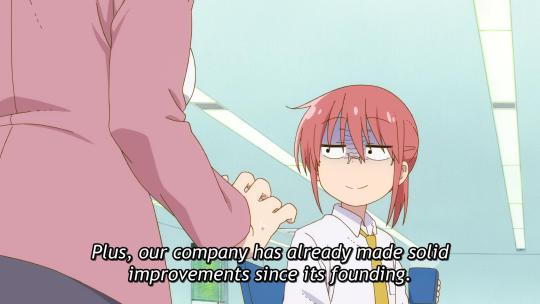
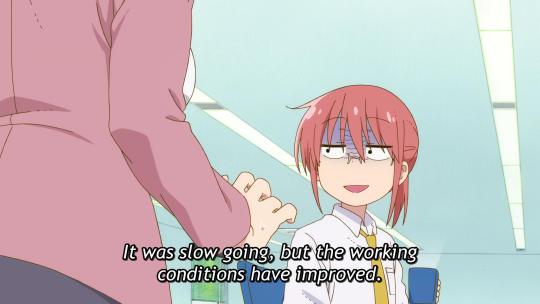
...設立から大分地盤が固まってきており、少しずつだが、業態は改善されている。
One thing to note here is that Kobayashi(‘s narration) isn’t saying the company has already made solid improvements, it’s that the company has finally established itself somewhat (as it was only founded relatively recently, and typically new companies are especially busy while trying to get off the ground) and now is starting to make improvements.
Similarly in the second sentence, it’s not “was” slow going, it’s “is still” slow going, and the working conditions “are” improving, not “have improved.”

This is がんば ganba, short of course for がんばって ganbatte, which I’m sure most of you are familiar with: the (in)famous “do your best.”
I only mention it because I like this shortened version of it. Ganba!

This is a fun little idiom(?)/saying: 鼻で笑う hana de warau (conjugated as hana de warawareta), lit. to laugh using the nose. It’s used to describe laughing at someone you’re looking down on for whatever reason (not necessarily in a super serious way, could just be a friend being dumb etc.; in this case it’s Elma’s being naive).
Typically it refers to like a “heh-but-through-the-nose” kind of “laugh,” but as you can see in this scene (where clearly Kobayashi is laughing with the mouth, even starting with “pff” lips) it works idiomatically even if the laughing isn’t only through the nose.
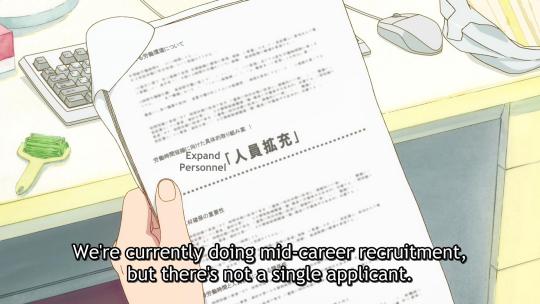

You may have heard that Japan is/was a “lifetime employment” country, where typically people would get hired right out of school and stay at that company until retirement. While that’s much less true today than it was even a couple of decades ago (and has become kind of controversial in ways), it’s still much more common of a practice than in say the US.
One result of this is that there’s a much bigger distinction placed between hiring people in spring as part of the annual graduation rush (the Japanese school year ends in March), and mid-career hiring. Typically you can’t participate in the fresh grad hiring if you aren’t one, even if you’re new to the field in question.
For larger employers (i.e. 5k+ employees), roughly two-thirds of all hirings come from fresh grads, and only small employers (<300 employees) hire more mid-careerists than people directly out of school.
Of course, this split tends to apply mostly to “standard” full time jobs, not so much part time, and is not necessarily a thing in every industry/at every company.

Just as a minor point of clarity, this “organized text” in Elma’s document refers to the phrase まとめられた文章 matomerareta bunshou. In a literal sense, matomerareta can mean organized/consolidated etc., and bunshou text/passages, but meaning-wise it’s more like “writing that gets its point across clearly/cleanly.”
This is a pretty big compliment and a very useful skill to have in organizations like this, as writing such that people can quickly and easily understand exactly what you’re trying to say often saves a ton of time and frustration.
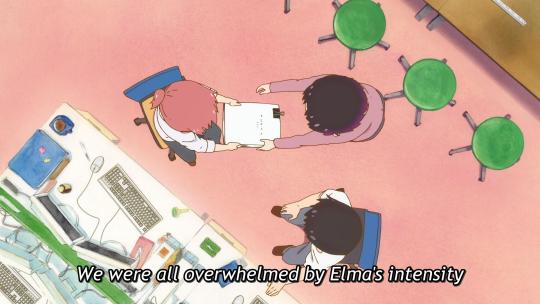
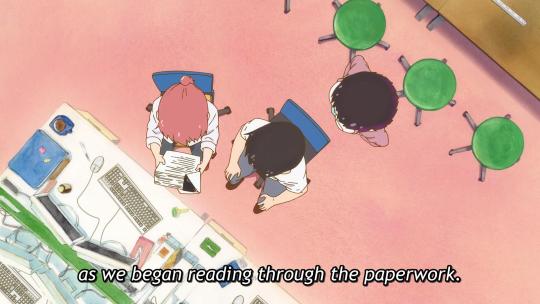
我々はエルマの気迫に押されるがままにその書類を読み始めた。
Another minor point, but where the English could imply that they were overwhelmed by Elma’s intensity through the act of reading her report, the Japanese implies more that they started reading it because of how intense Elma was being.
It doesn’t really make much of a difference either way, but it stuck out a little for me.
To justify mentioning it, I guess I’ll explain the grammar point Kobayashi uses: されるがままに sareru ga mama ni. Sareru is a generic verb/verb conjugation for having something done to you (technically here it’s 押される, to be “pushed/pressed/pressured”), and mama refers to a state, condition, or “way” (like “do it this way”).
Put together, the whole phrase is used to indicate “you” do/did something that someone else wants you to, without (meaningful) opposition. (Something similar in raw meaning but with a very different connotation would be “going with the flow.”)
If a friend says “hey let’s go do something,” and next thing you know you’re out bowling despite preferring to stay at home, this is you.
You can stick the mama ni to various other things as well to come up with a similar idea, but without the sareru the nuance may end up different.

The word for clairvoyance here is 千里眼 senrigan, lit. “eye(s) [that can see] a thousand li”, li being a Chinese unit of measurement for length (shorter than a mile, but for general purposes “eyes that see a thousand miles” is basically the gist).
Despite the perhaps physical-sounding nature of the term, it does actually describe the same power as “clairvoyance” in English: being able to perceive things outside your actual range of vision, including potentially into people’s hearts and minds etc.
Hence why it’s a thousand screen display, when she updates it with tech knowledge:

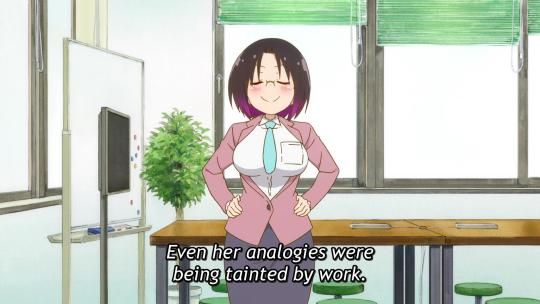
“Tainted by work” here is 職業病 shokugyou-byou, lit. an occupational disease. The “proper” definition is a disease one gets from working in a particular job, such as black lung for coal miners or even posture-related health issues for desk workers.
Additionally, it’s used colloquially to refer to noticeable habits or quirks that people in a certain profession pick up, like a baker always waking up super early or a programmer using programming lingo out of context in normal conversation. The latter being especially noticeable in Japanese, as a lot of such terms are English in origin.
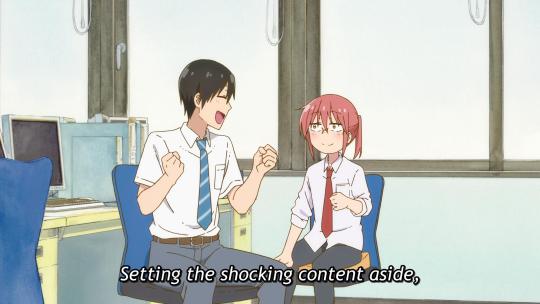
“Shocking” here is a fun word: ドン引き don-biki. “Don” here is added just for emphasis; the main meaning revolves around 引き hiki/biki, from the verb 引く hiku, meaning to pull.
The idea is that someone does/says something that you recoil from. Maybe it’s gross (“I only shower once a week”), maybe it’s mean (“They didn’t smile enough so I didn’t leave a tip.”), maybe it’s creepy (“I sent like 30 texts yesterday but still no reply.”), just anything that has you feeling like you might want to create some distance because... phew.
It’s kind of similar to the current use of “cringe” as an adjective/noun, though with less of an internet-slang feel* to it, and generally used more as something the speaker is doing rather than describing whatever/whoever is being cringe.
(*I think it started being used popularly in this way in the early-to-mid 90s, with the “don”biki variant specifically popping up around 2005.)
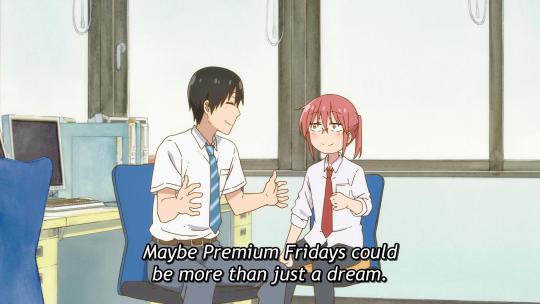
A “Premium Friday” is the last Friday of the month, where you get to leave work at 3 pm. It is largely theoretical.
The idea was created by the Japanese government as a way to reduce working hours and encourage domestic spending (boost demand), but it has not been implemented by all that many employers, and especially not many smaller employers. There isn’t, after all, any mandate or government-provided incentive for doing so.
Evidence from the places that did implement it suggests it is actually good for the economy, but good luck convincing bosses to give extra paid time off.
“Last Friday of the month” was chosen because most people get paid on the 25th each month (Japan tends to pay monthly instead of every two weeks), so it would usually be right after payday, when people are more willing to get spendy.

Kobayashi saying eight hours here reminded me of a “fun” fact: the typical Japanese work day is eight hours plus a one hour break. Plus a one hour break, not with. So a typical work day is actually nine hours. Most commonly 8 to 5 or 9 to 6. Not many “nine-to-fives” here.
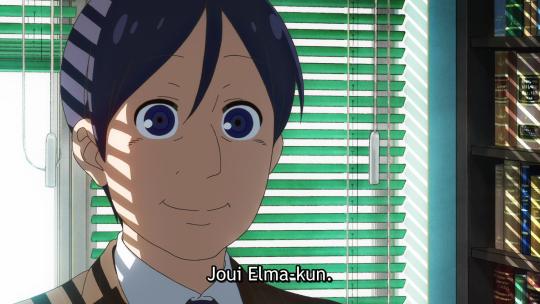
The characters for Joui are 上井, which usually read as Kamii or Uwai. It’s “Joui” because that means, when written as 上位, “superior.” As in “a superior life-form.” Like a dragon, say.
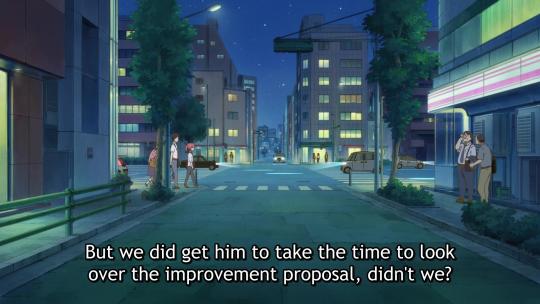
でも、ゆっくりやる事業改善案を見せてもらえたじゃない?
This one is actually kind of a critical mistake. In the English it sounds like she’s talking about the improvement proposal that Elma made and that the boss looked at. In the Japanese though, she’s talking about a different plan, one the boss showed them*, that is similar in idea but is going to take longer to be fully implemented**. So we’re being told that while Elma didn’t get what she wanted as fast as she wanted it, it is still basically going through at a slower pace.
*In ”見せてもらえた misete moraeta,” the misete vs mite means they were the ones who got shown something, rather than the ones who got someone to look at their stuff.
**Which you can tell from the ゆっくりやる yukkuri yaru, where yaru is basically “do” and yukkuri means (in this case) at an unhurried pace.
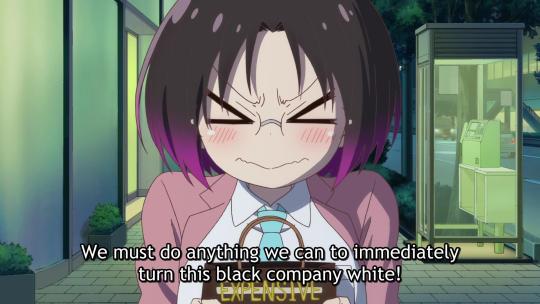
(Re previous note: Hence why she says “immediately” here.)
“Black (ブラック)” and “white (ホワイト)” in the context of Japanese employers refers to how well employees are treated: a company with good benefits/pay, reasonable levels of overtime, and feels safe to work at is “white,” while a company that has excessive overtime, often pays poorly, breaks labor laws, and allows harassment to fester is “black.”
While “white company” was created simply in contrast to the term “black company,” the latter finds its origins in front businesses for organized crime, which were called “black” in the sense of “illegal” (similar to “black market” or something being in a “grey area”). Given the international reputation of Japanese work life, you can imagine that “black company” as a term sees much more use.
There’s been some discussion about maybe replacing it due to the racial implications (especially since it uses the English word “black”), but while typically English translations drop the color for that reason (e.g. ブラック企業大賞, an “award” given to Japan’s worst employer each year, is officially “Most Evil Corporation of the Year Award” in English), it hasn’t really penetrated to the mainstream at this point.

The rice there is in a 飯盒 hangou, a metal container that looks… like that, and is the stereotypical item of choice for cooking rice while camping. It has its origins in the mess kits used by the military, but these days they’re primarily marketed as portable rice cookers for camping use.
You can get round ones too, but the bean shape is very popular.
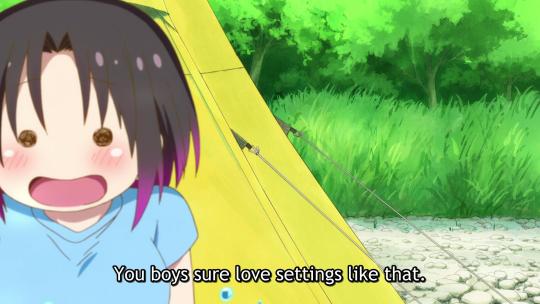
“Settings” here is 設定 settei, lit. exactly that, “setting(s).” E.g. if you open a computer program and look at the settings menu, it’ll be settei in the Japanese language settings (settei).
I bring it up here because there’s a bit of a difference in how it gets used colloquially like this. In English, the “setting” for a story typically refers to where and when it’s set. In Japanese, “setting” in that sense is usually 舞台 butai. But settei is still used when talking about fiction, just in a different, more expansive way.
Often in these cases settei is used to refer to the various conceits that provide the context in which the story takes place. In this show, for example, one such “setting” is that dragons are real: another is that magic exists. It comes up especially often in fantasy/sci-fi type stuff where there are major distinctions between that universe and the real world—not that stories in a real-world setting don’t have settei of their own, but they often are lumped into descriptions of the plot in that case (”a dragon comes to live with an office worker in her apartment”).
It also refers to the “settings” of characters, like name or age, and things like “they run a bakery that’s going out of business and are trying to save it.” Basically all the details you’d have in a character profile.
It also gets used in conversation to refer to pretend things or (basically) lies: like here, where Saikawa thinks Shouta is playing pretend with his ley-lines talk, or e.g. if someone is trying to tell you some outlandish story (“my uncle works at Nintendo…” or someone asking for love life advice for “their friend”) and you’re just like “Okay so that’s the settei here, I see.”

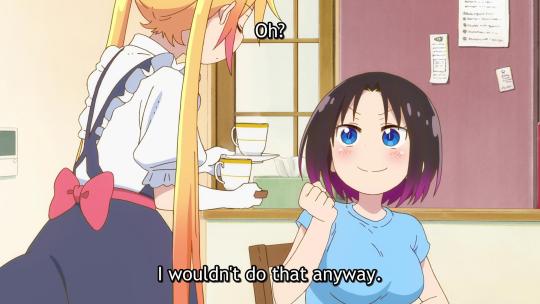
Not really a big deal, but Elma’s line here in Japanese implies she won’t let Tohru call her that anymore (see her もう mou). Tohru’s response is also more of a “I haven’t been?”, since of course she wasn’t aware of Elma’s-mental-image-Tohru tormenting Elma in the previous scene:
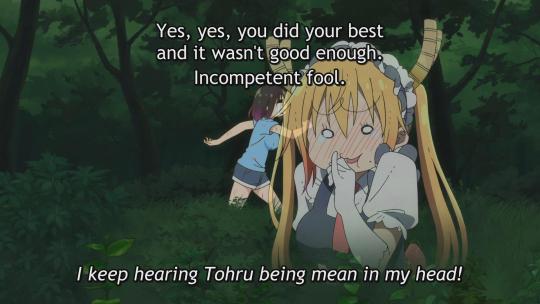
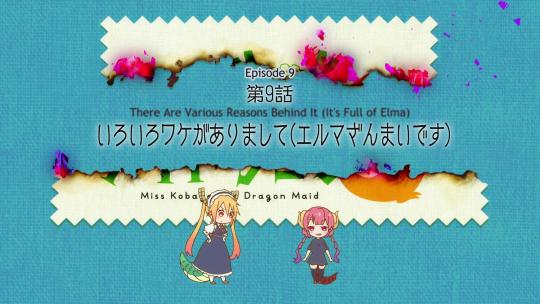
The word for “full of” in the title here is ざん��い zanmai (a suffix form of 三昧 sanmai), usually meaning that there’s a whole lot of [whatever] to immerse oneself in. I mostly bring it up because there’s a famous restaurant chain called Sushi Zanmai that specializes in, obviously, sushi.
And you know, Elma is a water dragon that looks kinda like an eel… I’m just sayin’…
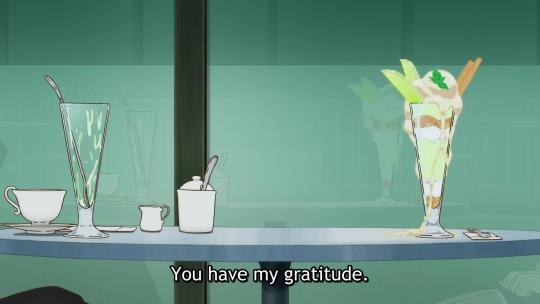
Not really a translation note, but wild that Elma didn’t even touch her parfait. (Not so wild that Fafnir finished his so quickly.) Serious business ahead...

“Genuinely” here is 素直に sunao ni, where the “ni” is used like “-ly” to make sunao work as an adverb. Sunao itself is an interesting word that falls into that category of “simple concept that is often hellish to translate.”
For some context, the first character, 素, is also used in the word 素顔 sugao, which is a face without makeup and 素材 sozai, basically raw ingredients/materials. The second, 直, is used in words like 直線 chokusen, a straight line, or 正直 shoujiki, honest.
Put them together, and you’ve got a word with connotations of directness and being unadorned. The original definition of the word tends toward “simple, natural” in the sense of e.g. life growing up on a rural farm.
The more common use for it these days is to describe people and their actions. Positively, it can mean something similar to a person being happy to help, or kind of like the opposite of conniving; open, frank, genuine. Less positively, it can mean someone is too trusting and easy to trick into doing things OR someone who is “too honest” and says hurtful things.
(If it helps: tsundere characters are often described as explicitly not sunao.)
In this case, the idea is that Tohru accepted the invitation easily as-is, without putting any conditions on it, or doing any “ugh, what a pain, do I have to, jeez” rigamarole—she just accepted. Another way you could put it in this case might be “It’s even more unusual for Tohru to accept an invitation like this without a fuss.”
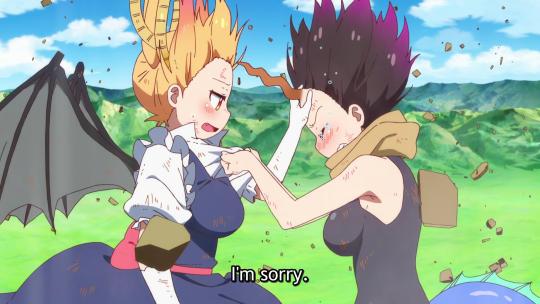
Just to point out the hand on head thing again.

Also just to point out that this is another example of otsukare, as a reminder of how ubiquitous that word is.
And it makes a good place to end on: thanks for reading!
44 notes
·
View notes
Note
for the meme: Abarat
the first character i ever fell in love with: *long, long sigh* yes, it was Christopher Carrion
a character that i used to love/like, but now do not: I’m sure there’s someone, but you have to understand that I’ve been waiting to reread until I know when Kry Rising is coming out. So like. It’s been a while.
a ship that i used to love/like, but now do not: I don’t think I’ve got any. Luckily(?) Abarat doesn’t have the magnitude of fandom that would lead me to become overwhelmed/annoyed with any particular ship
my ultimate favorite character™: *even longer sigh* yes, it’s Christopher Carrion. This bastard is vital to the story and if he wasn’t there it would just NOT be the same
prettiest character: Shoot, I’m blanking on the name but there’s this one illustration of a woman wrestling like, a skeleton snake I think, and that woman gets this honor
my most hated character: Rojo Pixler, but he’s definitely not meant to be liked anyway
my OTP: Candy/Carrion, and this time I am going to clarify. I DON’T want this to be canon, I just want the weird dynamic/tension to continue. The ship should remain primarily unspoken/subtext in canon. Candy does not need to deal with the level of fucked up Carrion is operating at at all times.
my NOTP: Candy/that rando that showed up at the end of book 3. I simply cannot believe this is going anywhere, it’s too love-at-first-sight to be taken at face value
favorite episode: The first book, if only because it’s the gateway into the new and incredible world of the Abarat
saddest death: This sounds terrible because like, a lot of characters do die, but I don’t remember being super sad a lot during these books (I’VE FORGOTTEN A LOT OKAY…it’s been like a decade). Of characters that are perma-dead…Squiller the squid-binoculars (at least I think that little guy died?)
favorite season: NA
least favorite season: NA
character that everyone else in the fandom loves, but i hate: The fandom is so small…this question doesn’t really apply
my ‘you’re piece of trash, but you’re still a fave’ fave: I kind of want to say Carrion again, but calling characters trash has never been a piece of fandom slang I’ve really felt I fully understood. He’s a villain? Then again he has literally washed up on a beach as a mostly dead thing, so he kind of has been a literal piece of trash at one point.
my ‘beautiful cinnamon roll who deserves better than this’ fave: Malingo…he should quit while he’s ahead (ba-dum-tish)
my ‘this ship is wrong, nasty, and makes me want to cleanse my soul, but i still love it’ ship: Um, obviously Candy/Carrion? That’s the point?
my ‘they’re kind of cute, and i lowkey ship them, but i’m not too invested’ ship: Candy/Malingo. It makes sense. They’re actually friends. At the current narrative point it would make sense, if Candy needed to be in a relationship, to have her be with Malingo.
10 notes
·
View notes
Note
i suppose this is somewhat of a rambling question asking for advice... firstly, i am not particularly new to the concept of kin identities and theriotypes, having been in communities more centered around fictionkin in the past as i did (and still do) identify with multiple fiction kintypes, albeit i was probably present in particular groups when i was too young to particularly process it all, especially with certain group members discussing heavier topics and getting into infighting that put me off.
i suppose lack of... diligence, for equal lack of a better term, after growing apart from those retrospectively unhealthy communities made me lax in my own definitions and confirmation of my own kintypes, and while i know, psychologically, i *do* identify as these characters to cope and to support my sense of self, and am certain with no room for self-debate that they and i are one and the same in either presented canon or alternate worlds, i can't help but feel the fact i have a casual disposition about kin, use kinnie and kinning if anything for the snap they have as words that amuse me, and that i generally present socially with all the surface levity people associate with fadchasers, among the fact i don't quite feel reincarnate, just a sense of "that is me, i am you" from characters...
The fact I can rattle off this many traits that I see looked down on especially with newer psych or copekin folk (or misguided c-linkers, definitions and personal experiences depending) it just makes the idea of attempting to reintegrate, or at least find folks to talk to who won't view me as a nuisance in the current kin-centric communities *for adults* very daunting. i've gotten too old to feel like newer gen places with more of a minor crowd are a place i should be present, let alone frequent or make friends in, especially after once trying to branch out there ended with meeting a horrifically unpleasant individual that tormented me for a full year. i've just been at a loss of where I would be able to go, especially now after finally reconciling an otherkin kintype i've felt pangs about since childhood. i've been wanting to celebrate in the achievement of self-discovery, maybe make a friend or two, but i don't know if there's a place where i can be present as i am, with genuine feelings marred with vague explanations for many of my kintypes, and not be combatively invalidated as i've heard can happen, often moreso with primarily fickin folk like myself in experiences i've heard of.
i suppose this message did turn more into talking through getting a weight off my chest than asking for advice by now, but if there are any sort of suggestions you have with regards on where to poke my head in to find community with peers in my age group, or otherwise, I'd very greatly appreciate it. if being on anon compromises that because of the unfortunate frequency of trolling towards the community, i understand, and regardless i thank you for having patience to read through this, and hope you have a pleasant evening.
It’s fine to be ‘casual’ about otherkin identities. You don’t need to post about your otherkinity/nonhumanity to be valid (for lack of a better term), nor do you need to meet any other requirements than identifying as your kintype.
Though I will be honest, the language you (general you) use does impact which people will want to talk to you. If you use ‘kin’ as a verb, rather than a noun, and refer to yourself as a ‘kinnie’ a lot of older community members will paint you with the same brush as the younger ‘kin for fun’ crowd. This is not to say that you can’t find older, more mature/confident, or ‘serious’ people who will welcome you - just that it will make it significantly harder for you.
Still, it’s definitely worth it to put in the effort to meet new people. If you just start posting a lot in the main tags, regardless of what slang you use, you will eventually find people to both share your otherkin experiences with and to chat casually with (whichever you need). Just be clear about what kind of companionship you’re looking for so everyone’s on the same page.
Joining Discord servers is also a viable option, though I don’t know of any good, active, small ones. And of course there’s the Nonhuman National Park forum.
4 notes
·
View notes
Text
Understanding Sun Myung Moon’s attitude to sex by taking a look at Korean history
by a Korean professor
Human Dignity and Sexual Culture:
A Reflection on the ‘Comfort Women’ Issues
Chunghee Sarah Soh, Ph.D.
San Francisco State University
Introduction
The purpose of this paper is to reflect on a particular dimension of the complex issues involving the Comfort Women movement for redress by focusing on what I call ‘masculinist sexual culture’. For the purpose of this paper I use the term ‘masculinist’ to refer to those men and women who believe not only in the Confucian principle of male superiority but also in male ‘sex-rights’(1) to have access to the female body both inside and outside marriage. Masculinists believe that men, in contrast to women, have biologically rooted sexual needs, and consequently, concede to men their ‘natural’ right to seek sexual comfort, both premaritally and extramaritally. Masculinist sexism permeated the traditional cultures of Japan, Korea and other patriarchal societies and is still prevalent today.
The androcentric euphemism ‘comfort women’ (ianfu) is an official coinage of imperial Japan, and was used to categorically refer to young females of various ethnic and national backgrounds and social circumstances who became sexual laborers for the Japanese troops before and during the Second World War. In contrast, the soldiers came to refer to these women as the ‘pi’ (pronounced as ‘pea’), a Chinese term meaning goods or articles, which, as a slang term, stood for female genitals.(2) The estimates of the number of women used as comfort women range between 50,000 and 200,000.(3) It is believed that about 80% of them were Korean.(4) There is no documentary evidence to determine either how many women were used or how many were forced to serve as military comfort women, except for the Dutch case.(5)
Seen from an anti-Japan, nationalist perspective prevalent among activists especially in South Korea, the comfort women issue is simple and clear: Japan as a colonial power exploited Korea’s human resources by rounding up tens of thousands of young unmarried girls and women to be used as military sex slaves. Seen from a more global perspective, however, the issues involved in the comfort women case are complex, running the gamut from the problem of ‘militarized prostitution’ to that of sexual slavery based on gender, age, social class, and ethnicity. Coerced sexual labor, i.e., sexual slavery, was inflicted primarily upon lower class young females of colonial Korea by imperial Japan during the Asia-Pacific War,(6) but not every former comfort woman had been forcibly drafted by the state power. In addition, while teenage Korean maidens from impoverished families constituted the overwhelming majority, relatively older Japanese prostitutes, and primarily lower-class women of colonized Taiwan and other occupied territories were also used as comfort women during the “Fifteen Year War” of aggression pursued by imperial Japan, starting from the Manchurian invasion in 1931 to its unconditional surrender in 1945.
At the core of the contestation over the representation of the military comfort women as sex slaves versus licensed prostitutes(7) lies the issue of state responsibility in forced recruitment of comfort women and the maintenance of the comfort system. On a deeper level, however, many of the central issues around sexual violence in warfare and its relationship to the cultural constructions of gender and human sexuality--more specifically heterosexuality--in patriarchal societies, are being called into question, including the masculinist sexual culture and the perennial question concerning the proper relationship between prostitution and the state. The Rest & Recuperation program for the U.S. soldiers during the Vietnam War was a recent example of a state institution looking after the physical needs of military men.(8) In fact, there still exist thousands of prostitutes in the kijich’on, the U.S. military camptowns in South Korea, and the Korean media used to refer to them as wianbu (“comfort women” in Korean).(9)
The comfort women movement formally began in South Korea in November 1990. The Korean Council for Women Drafted for Military Sexual Slavery by Japan (hereafter, the Korean Council), a non-governmental organization (NGO), is responsible for internationalizing the comfort women issue as a war crime and violations of women’s human rights in situations of armed conflict. With a series of hearings by the United Nations Commission on Human Rights (UNCHR) beginning in 1992, the comfort women issue leaped to the attention of the world community nearly half a century after the end of the War. The Korean Council as a newly formed NGO has accomplished in less than a decade a level of success that went beyond the wildest dreams of the leadership in bringing the attention and support of the international community for their reparation demands against the Japanese government.(10)
As a sociocultural anthropologist specializing in gender issues, social inequality and the processes of culture change, I have followed closely the developmental processes in the internationalization of the Korean comfort women movement from the start. In addition, I have conducted ethnographic field research in Korea, Japan, and the Netherlands. As an example of ‘multi-sited’ ethnographies George Marcus discusses in his latest work,(11) this ongoing research aims to present from the perspective of critical anthropology a multilayered analysis of the complex issues involved in the redress movement. As a Korean American interested in comparative studies of the cultures of Korea and Japan, my goal is to go beyond the national boundaries and to present a balanced and nuanced analysis of once an unproblematized and almost forgotten issue of comfort women from the perspectives of cross-cultural, critical anthropology. And in order to do that, we must delve into the intersections of sex, power, and justice, not simply in heterosexual relations between men and women but also in international relations between nation-states of unequal power.
In this paper I will trace the social origins of the movement and to consider the tasks that remain to be tackled at the societal level in order to help prevent gendered violence against women from occurring not only in situations of armed conflict but in everyday life in many patriarchal societies. One of these tasks, I believe, is to start serious public debate on the ‘masculinist sexual culture’ that is at the root of diverse forms of pervasive social oppression and sexual violence against women.
Indeed, I would argue that it is masculinist double standard for sexual conduct that has contributed to lifelong psychological sufferings for an untold number of comfort women survivors because they were socialized to regard the loss of virginity as a shameful condition deserving social ostracism. Generally speaking, these survivors were socialized from childhood to regard the preservation of sexual purity (chongjol) as important as life itself. Thus, when they returned home after the war, some women were unable to reveal their ordeals even to their mothers. They gave up any hope of finding men who would accept them as legitimate wives if/when they found out about the loss of their virginity and their past as comfort women. They carefully hid their past for fear of social stigma and ostracization its revelation would bring to them and their family. Given the sexual mores of the Korean patriarchy, it is understandable that the survivors of sexual slavery for the troops of imperial Japan during WWII kept their silence for nearly half a century until the early 1990s. Some of them still refuse to reveal their past as comfort women. Others insist on using pseudonyms.
I should point out here that until the redress movement began, the Korean society generally regarded Japan’s comfort system as a military version of licensed prostitution. Koreans are justifiably angry that imperial Japan forcibly recruited young girls and women of colonial Korea for prostitution and sexual enslavement. However, they are unwilling to acknowledge the complicity on the part of some Koreans, which is amply revealed in the survivors’ testimonies. Korean men--and sometimes women as well--participated in the deceptive and/or forcible recruitment and some did so with a purpose of economic gain.
Le me now provide an historical overview of the masculinist sexual culture in Korean society and the social and political economic context that contributed to the emergence of the comfort women movement. In particular, we will examine the phenomenon of kisaeng tourism and consider the plights of the kijich’on sex workers in South Korea in order to highlight the underlying, invisible threads of masculinist sexual culture combined with the political economy of global capitalism that continue to influence the patterns of unequal power relations between the sexes and nation-states in the everyday lives of women working in the sex industry.
Korean Sexual Culture: An Historical Overview
Not many people are aware of the fact that the Korean comfort women movement grew out of feminist and nationalist opposition to the phenomenon of the so-called kisaeng tourism, which is a euphemism for prostitution tourism. The term kisaeng traditionally referred to professional female entertainers. The institution of kisaeng or kinyô was firmly established in Korean society by Koryô dynasty (918-1392) and continued throughout Chosôn dynasty (1392-1910).(12) Kisaeng were chosen from among young females of the lower classes and trained in the arts of entertainment for men, such as playing musical instruments, singing and dance. By the time of King Sejong (r. 1418-50), prostitution came to dominate the life of kisaeng. There were several proposals to abolish the institution of kisaeng by high-level Confucian scholar-officials. However, the opponents to the proposal successfully defended the institution by arguing among other things the likelihood of increased sex crimes if it were to be abolished.(13)
In the masculinist sexual culture, it is not surprising that such a biological-determinist argument would win the debate with relative ease and could continue to defend masculinist interests in satisfying men’s desire for sexual recreation by supporting the social institution of kisaeng and the customary practice of acquiring a chôp (concubine). The masculinists upheld the double standard for sexual behavior of men and women by classifying women into two types according to the main functions of their sexuality: women to marry for procreation and women to hire for recreation. The custom helped to further discriminate women according to their marital status. While married women as mothers and wives were accorded due respect for their contributions to the family life, unmarried women working as professional entertainers were social outcastes and were commodified as sexual playthings. Even when a kisaeng was taken as a concubine of a yangban (upper-class) man, she suffered legal and customary discrimination as a secondary wife. She could not participate in any formal events of the family. Her children were labeled as sôja (illegitimate offspring) in contrast to the chôkcha (‘legitimate children’ born of the lawful wife).
Typically, men in traditional Korea, especially those belonging to upper classes and working for the government engaged in recreational sex supported by the state-run system of kisaeng and the customary practice of concubinage. Traditionally, the masculinist sexual culture in Korean society rigidly controlled women’s sexuality by means of the cult of female virginity/chastity while it condoned, if not encouraged, sexual freedom for unmarried men and generally overlooked infidelity of married men. As mentioned earlier, unmarried women were expected to maintain their virginity until marriage and widows, especially of the upper classes, were prohibited from re-marrying. Regardless of the individual circumstances, women who lost their chastity were considered sullied, made to feel ashamed, and likely to be ostracized by their own families. In this cultural context, many women committed suicide after being raped or in order to avoid being raped during the two Japanese invasions of Korea in the late 16th century. Their deaths were recognized as honorable deeds of yôllyô (virtuous women), whose families were honored by royal commendations.(14)
When some widows of lower classes remarried out of economic necessity, they usually had to leave their children of the deceased husband behind, either with the late husband’s relatives or with their own natal family. In the case of Kim Hak-sun (1924-1997), who became the first Korean survivor to give a public testimony of her life as a “comfort woman” in 1991, her remarried mother left Hak-sun with a foster father. He sent Hak-sun to a training school for the kisaeng. When she finished her schooling, the foster father took her to China hoping to find her a job there since as a seventeen-year-old minor she was not allowed to work yet in Korea. It was there that she was taken by the Japanese military to a comfort station.(15) In the case of Kang Tôk-kyông (1929-1997), another former comfort woman, she lived with her maternal grandparents after her widowed mother remarried. She joined the so-called ‘Women’s Volunteer Corps’ or Yôja Chôngsindae in Korean in defiance against her estranged mother’s advice. She worked at a factory in Japan and fled from her factory dormitory to escape from hunger and hard life only to be caught by the military police and taken to a comfort station. The point here is that the tragic lives of numerous former comfort women, the great majority of whom came from poor families in rural areas, were embedded in the intersections of gendered oppression in the patriarchal marriage and family system and class inequality, as well as colonial exploitation.
Prostitution and Women’s Movement in South Korea
In the twentieth century, Japan’s colonization of Korea and its assimilation policies resulted among other things in the transplantation of some Japanese terminologies(16) and social institutions, such as the systems of family headship (hoju) and licensed prostitution, in Korean society. Thus, Japan’s modern system of licensed prostitution was firmly grafted in the soils of colonial Korea by the mid-1910s. It was formally abolished in post-colonial Korea in 1947.(17) Nevertheless, prostitution of female sexuality as a commodity has continued in South Korea in a variety of manners and places, sometimes with semi-official support, as exemplified in the development of kisaeng tourism targeting Japanese male visitors and the kijich’on sex industry catering to the U.S. military.
Kisaeng/Prostitution Tourism
It is not clear when and how the kisaeng tourism emerged in South Korea but it came to flourish by early 1970s after Korea and Japan signed the bilateral agreement to normalize diplomatic relations in 1965. The increase in the number of Japanese visitors to South Korea after 1965 has been phenomenal. In 1965, there were 5,110 Japanese visitors and 14,152 American visitors. By 1971 the Japanese visitors (96,531) greatly outnumbered those from the United States (58,003). In 1973, nearly half of a million (436,405) Japanese tourists visited South Korea, which was more than eighty-five times increase over the figure for 1965. And the 1973 figure was more than double the previous year (217,287), which was mainly due to Japan’s severing of diplomatic relations with Taiwan in September 1973. The majority of the Japanese men who visited Korea for the purpose of kisaeng party, according to a study by a Korean Christian women’s organization, came from lower classes to enjoy sexual entertainment at the one-fifth of the cost required for comparable service in Japan.(18)
In the 1970s Korean women who wished to work formally for foreign tourists staying at hotels had to acquire a license that certified their health status and the completion of required orientation education. The contents of the orientation lectures given by university professors were a modern version of those for imperial Japan’s Yôja Chôngsindae, the Women’s Volunteer Corp, emphasizing the importance of their work in earning precious foreign currency for the nation’s economic development.(19) I should mention here that in the 1970s the Korean government was also engaged in the surveillance and authoritarian control of the prostitutes servicing the US military. At the request of the latter that complained of the unhealthy conditions of the kijich’on sex industry, the Korean government started a clean-up campaign in 1971 that included infrastructural improvements and enforcement of regular medical examinations of prostitutes, detaining infected women at special centers.(20)
Women’s Activism: Linking Kisaeng Tourism to Wartime Comfort System
The first organized protest by women in Korea and Japan against kisaeng tourism took place in December 1973, both in Seoul and Tokyo.(21) Ewha Womans University students staged a demonstration at Kimpo Airport confronting Japanese tour groups with a placard reading, “Stop Sex Tourism”. Representatives of women’s organizations in Japan demonstrated at Haneda Airport in Tokyo in front of Japan Air Lines office aiming at Japanese tour groups and carrying placards reading, “Don’t go to Korea for sex tourism.” As of 1979, an estimated 100,000 women worked as tourism kisaeng.(22) In some cases, tourists at kisaeng houses/restaurants could choose their partners among those gathered in the waiting lounge. A Japanese tourist who contributed an essay to a magazine published in Japan compared figuratively his experience of kisaeng party to that of going to a slave market.(23) By late 1970s sex tourism spread to Southeast Asia, particularly the Philippines and Thailand. By early 1980s Japanese businessmen started running kisaeng houses in Japan by importing Korean women. In 1988 the Korean Church Women United sponsored the International Conference on Women and Tourism in South Korea. It was there that Professor Yun Chông-ok of Ewha Womans University first presented her research on Korean comfort women issue, which helped the participants from Korea and Japan see the underlying linkage between the issues of the comfort women in colonial Korea and kisaeng tourism in contemporary Korea. (24)
In January 1989 when the Korean government sent an emissary to the funeral of Emperor Hirohito, women’s organizations in South Korea protested to the government for not taking up against the Japanese government the unresolved issues of the latter’s postwar responsibilities including the comfort women issue. Feminist activists raised the same issues during the state visit of President Roh Tae Woo to Japan in May 1990. The comfort women issue was first raised in Japan’s Diet in June 1990 when a government official flatly denied any involvement of the state in the recruitment of comfort women. This denial angered women activists in Korea to an action that resulted in the formation of the Korean Council in November 1990. And the rest, as they say, is history.
I should also mention here that until the 1980s, when the Korean and U.S. troops regularly conducted the joint military exercises called “Team Spirit,” the kijich’on sex workers became camp followers.(25) Calling themselves “the blanket brigade,” they would follow the soldiers’ move during the exercise and each would offer sexual service to twenty to thirty soldiers a day. In the 1990s, the joint military exercises were curtailed but the camp following prostitution for the U.S. military continues, generating the coinage of the ‘second generation of military comfort women’. The activists working for the kijich’on sex workers point out that the historical legacy of Japan’s comfort women continues in Korea’s kijich’on serving this time the U.S. military. The atrocities of Japan’s imperial army in violating women’s human rights have been revealed in recent years, but few people in the United States are aware of heinous sexual crimes committed by American military men, most of whom go unpunished due to the unequal Status of the Forces Agreement (SOFA) contracted between the superpower United States and the newly industrializing Republic of Korea in 1967.
Let me mention one murder case that prompted an unprecedented mass demonstration of 3,000 people in a kijich’on called Tongduch’ôn in 1992.(26) Kenneth Markle (twenty years old at the time of the crime), a private of the U.S. Army stationed in South Korea, murdered Yoon Keum-I, a twenty-six-years-old sex worker, by battering her with a Coke bottle and stuffing it into her womb. He also shoved an umbrella into the anus of the bleeding, dying woman and stuffed matches into her mouth. He then sprinkled soap powder over her body, apparently to eliminate evidence of the murder. The cruelty of the crime enraged the residents of the kijich’on to stage a series of mass demonstrations, and eventually contributed to the formation of an NGO, “The National Campaign for Eradication of Crime by U.S. Troops in Korea,” in 1993. According to them, an average of two crimes were committed daily by U.S. troops from January 1993 to June 1996 and that on average the Korean government exercises jurisdiction in 0.7 percent of cases. The above-mentioned murder case is one of the very few cases in which the criminal is serving his sentence in a prison in South Korea.
Concluding Remarks
In the Korean media and official discourse, prostitutes are referred to as yullak yôsông, literally ‘ethically fallen women’. Yet men who purchase sexual service from these ‘fallen women’ are not called ‘ethically fallen men’, reflecting the fundamental bias against women sex workers in masculinist sexual culture. It is in this social and cultural context that some survivors have chosen not to reveal their past, and I am sorry to report that some of those who did had to suffer ostracism from their relatives and friends after their coming out. The survivor I interviewed in April 2000 was most bitter about it.
If we are serious about our commitment to the enhancement of life conditions of humanity, we must confront the global realities of predominance of men’s sex-rights over women’s human rights,(27) be they sex workers, single or married women. Many women and children who work in the sex industry whether willingly or forcibly are predominantly from poor families in search of livelihood. Prostitution is regarded as the world’s oldest profession and no society has gotten rid of it. If this new century is to be a century of human rights, we cannot avoid the issue of human dignity of sex workers in the booming international sex industry in which consumers of sexual service belong to richer classes and/or more powerful nation-states that not only exploit providers of sexual service economically but also demean them socially and psychologically.
Although there are various signs of significant change in the patterns of gender power relations, masculinist sexism that permeated the traditional sexual cultures of Korea, Japan and other patriarchal societies is still prevalent today. More than a quarter of a century after women began fighting against sex tourism, Japanese men’s sex tours flourish discreetly in South Korea. In December 1998, the police in Seoul arrested fifteen people including the bosses and employees of five sex trade organizations. What shocked the public was that the women involved in the sex tours included not only professional women working in the entertainment industry but also television and theater actresses, fashion models, foreign flight attendants, department store employees, and graduate school students.
The sex crimes of the U.S. servicemen in South Korea continue. The latest murder of a Korean woman working at a bar for foreigners in Itaewon by an American soldier that came to my attention was first reported in a newspaper on March 29, 2000. The soldier, a twenty-two-year-old corporal, fled from the 8th U.S. Army compound after a consultation session with a lawyer in the morning of April 28, 2000, when the first hearing on his murder charge was scheduled at Seoul District Court.(28) The Korean police arrested him several hours later but had to hand him over to the U.S. authority due to the SOFA terms.(29)
To conclude, human rights activists for the comfort women issue in Korea and elsewhere, whose representation of comfort women as military sex slaves has focused on Japan’s postwar responsibilities, must acknowledge that masculinist sexual culture was at the root of the comfort system, and address a fundamental social and political reality that the gross violations of human rights of comfort women originated from power inequity between the sexes, classes, and nation-states. One of the social implications of personal ordeals former comfort women had suffered both during and after the war is that similar tragedies will befall many more women unless patriarchal societies change their sexual culture. Prostitution is conventionally defined in terms of unethical behaviors of ‘fallen women’ while many men commonly depend on the sexual labor of socially despised women. We must move away from the mentality of blaming the victims to that of according full humanity to the downtrodden and search new ways to deal with old problems in order to help improve life conditions for all humankind. The masculinist sexual culture must give way to a humanist sexual culture in which each person’s humanity is respected regardless of sex, race, and social status.
Acknowledgements:
I acknowledge with gratitude the financial support from the Northeast Asia Council for the Association for Asian Studies, San Francisco State University, the Japan Foundation, and the International Institute for Asian Studies of the University of Leiden, the Netherlands, which funded field research in Korea, Japan, and the Netherlands. The research time to write this paper was supported by a grant from the Research and Writing Initiative of the Global Security and Sustainability Program of the John D. and Catherine T. MacArthur Foundation, for which I am thankful.
Endnotes
1. See Pateman 1988.
2. Nishino 1992:46.
3. See Yoshimi 1995:79-80.
4. Hata (1998) asserts that Japanese women, not Koreans, constituted the majority ethnic group at comfort stations set up for exclusive use of the military.
5. See Soh 2000a for a further discussion of the Dutch case.
6. In this article I add Asia to the term “Pacific War” (which Ienaga [1978:xiii] uses to cover the “Fifteen Year War,” from the Manchurian Incident in 1931 to Japan’s defeat in 1945) with a purpose to highlight human sufferings experienced by the peoples in Asia during that war.
7. See Soh 2000a.
8. For more details see Enloe 1990, 1993; Sturdevant and Stoltzfus 1992.
9. See Soh 1996.
10. Interview with Yun Chông-ok, a co-representative of the Korean Council, January 7, 1995.
11. Marcus 1999.
12. Kwon 1999.
13. Ibid., pp. 215-217; Chang 1986.
14. See Kim et al. 1972.
15. For Kim’s testimony, see Chôngsindae Yôn’guhoe and Chôngsindae Munje Taechaek Hyôpûihoe 1993.
16. Korean automobile mechanics and many drivers use the Japanese term, jôshi, to talk about the condition of the engine. For example, engine jôshi ga chotta (The engine is in good condition) uses the Japanese term, jôshi, as well as the English term engine.
17. Licensed prostitution was abolished in postwar Japan in 1946 (see Garon 1997).
18. For more details, see Korean Church Women United (KCWU) 1983.
19. Ibid., p. 24.
20. See Moon 1997.
21. See KCWU 1983: 55-56.
22. Han’guk Kyohoe Yôsông Yônhaphoe 1983:23.
23. Ibid., p. 16.
24. For more details, see Soh 1996.
25. See H. S. Kim 1997.
26. The National Campaign for Eradication of Crime by U.S. Troops in Korea, n.d.
27. See Soh 2000b for a discussion of the meaning of women’s human rights for the survivors.
28. Han’guk Ilbo (April 29, 2000, B11).
29. KBS TV evening news, April 28, 2000.
References
Chang, Sa-hun. 1986. “Women Entertainers of the Yi Dynasty.” In Women of the Yi Dynasty, ed. Park Young-hai. Seoul: Research Center for Asian Women, Sookmyung Women’s University.
Chôngsindae Yôn’guhoe and Chôngsindae Munje Taechaek Hyôpûihoe, eds. 1993. Kangje-ro Kkûllyôgan Chosônin Kunwianpudûl (Forcibly Recruited Korean Military Comfort Women). Seoul: Hanul.
Enloe, Cynthia. 1990. Bananas, Beaches & Bases: Making Feminist Sense of International Politics. Berkeley: University of California Press.
______. 1993. The Morning After: Sexual Politics at the End of the Cold War. Berkeley: University of California Press.
Garon, Sheldon. 1997. Molding Japanese Minds: The State in Everyday Life. Princeton, NJ: Princeton University Press.
Han’guk Kyohoe Yôsông Yônhaphoe (HKYY). 1983. Kisaeng Kwan’gwang (Kisaeng Tourism). Seoul: HKYY.
Hata, Ikuhiko. 1998. “‘Ianfu densetsu’ o minaosu” (Rethinking the ‘comfort women legend’). In ‘Ianfu’ mondai to azia josei kikin (“Comfort Women” and Asian Women’s Fund), ed. Onuma Yasuaki, Shimomura Mitsuko, and Wada Haruki, pp. 197-199. Tokyo: Toshindo.
Ienaga, Saburo. 1978. The Pacific War: World War II and the Japanese, 1931-1945. Trans. Frank Baldwin. New York: Pantheon Books.
Kim, Hyôn-sôn. 1997. Kijich’on, Kijich’on Yôsông, Honhyôladong Silt’ae wa Sarye (The status and cases of Kijich’on, Kijich’on Women, and Children of Mixed Blood). Seoul: Saeumtô.
Kim, Ok-gil et al. 1972. Han’guk Yôsôngsa (History of Korean Women). Seoul: Ewha Womans University Press.
Korea Church Women United (KCWU). 1983. Kisaeng Tourism. Seoul: KCWU.
Kwon, Sun-hyông. 1999. Koryôsidae Yôsông i Kyubôm kwa Saenghwal (The norms and lives of women of Koryô). Pp. 135-162. Uri Yôsông i Yôksa (History of Our Women). Seoul: Han’guk Yôsông Yôn’guso Yôsôngsa Yôn’gusil.
Marcus, George E. 1999. Ethnography through Thick and Thin. Princeton, NJ: Princeton University Press.
Moon, Katharine H. S. 1997. Sex among Allies: Military Prostitution in U.S.-Korea Relations. New York: Columbia University Press.
National Campaign for Eradication of Crime by U.S. Troops in Korea (NCEC). N.d. Cases of Crimes Committed by U.S. Militarymen. Seoul: NCEC.
Nishino, Rumiko. 1992. Jugun Ianfu: Moto Heishitachi no Shogen (Military Comfort Women: Testimony of Former Soldiers). Tokyo: Akashi Shoten.
Pateman, Carole. 1988. The Sexual Contract. Stanford, CA: Stanford University Press.
Soh, Chunghee Sarah. 1996. Korean ‘Comfort Women’: Movement for Redress. Asian Survey 36(12):1227-1240.
______. 2000a. From Imperial Gifts to Sex Slaves: Theorizing Symbolic Representations of the ‘Comfort Women’. Social Science Japan Journal 3 (1):59-76.
_____. 2000b. Human Rights and the ‘Comfort Women’. Peace Review (In press).
Sturdevant, Sandra P., and Brenda Stoltzfus. 1992. Let the Good Times Roll: Prostitution and the U.S. Military in Asia. New York: The New Press.
Yoshimi, Yoshiaki. 1995. Jugunianfu (Military Comfort Women). Tokyo: Iwanami Shoten.
http://www.icasinc.org/2000/2000s/2000scss.html
______________________________________________
Psychological Terrorism by The Unification Church at Cheongpyeong
Excerpts from Korean comfort woman Mun Ok-chu’s memoir
Almost all these Comfort Station managers / owners were Korean
Koreans who experienced the Japanese annexation of Korea explain some facts
Sun Myung Moon: “Women have twice the sin”
“About 100 Korean women were abducted by Korean prostitution brokers but were rescued by the Japanese military police.”
Japanese woman recruited by the Unification Church and sold to an older Korean farmer
6,500 Japanese women missing from Sun Myung Moon mass weddings
6 notes
·
View notes
Note
I'm really interested in your Cats universe! It seems like you have them living like humans but humans also exist? Can you describe your universe a bit more, if you'd like to? :)
I'd love to!
I must warn you though, this is a very in-depth universe, and even focusing on specific points and trying to simplify things as much as I could, I still managed to make to this about a mile long. Damn I wish Tumblr mobile let me do a read more cut
First of all, yes the Cats are anthropomorphic, and yes humans also exist in this universe. Anthro Dogs, Rats, and Mice all definitely also exist, and I'm considering a few other anthro races like Hyenas and maybe like Rabbits and some others, but haven't put too much thought to that yet.
Just for reference, if it's capitalized (Dog, Cat, etc) it's the anthro race, if it's lower case (dog, cat, etc) it's the fourlegger
Some Basic Terminology:
Non-human beings/non-human people - collective term for all anthro races
NHP - non-human person(s)
Furfolk - common English slang for non-human beings, not politically correct but still pretty widely used. There is also a version of this word for each specific race, Catfolk, Ratfolk, etc. (Note: Mice and Rats often are collectively refered to as Rodents or Rodentfolk)
Fourlegger - regular dogs, cats, etc. Used mostly by NHPs to differentiate between them and NHPs
Bald-bodies - humans. Used by NHPs, considered derogatory by most (nearly everyone uses it anyway)
Kit - kid, child, teenager (for Cats). Short for kitten
Tom - you know this one, an adult or teenage male Cat
Mot - an adult or teenage female Cat, an alternative word for "queen"
License Name - once called the "family name" back when it was still quite common for Cats to work for a human family in a residential household. Essentially this is the name that humans assign to Cats because Particular Names are often "too hard" for humans to remember/pronounce. It's their "official" name that appears on most legal documents, including their "license" which is essentially a registration card and number that all Cats are required to have. Most Cats have a license, and a license name, by age three, some get theirs as infants. Sometimes the parents have a say in what the license name will be, sometimes not. Sometimes a Cat will prefer their license name, some prefer their Particular Name, others don't care and will respond to either.
The Junkyard - a slum, mostly populated by Cats, on the outskirts of the metropolitan area of an unnamed imaginary British city, comprised partly of makeshift shelters scattered throughout an actual dump/landfill/junkyard, and partly of several large shantytowns built on the unused land surrounding the dump
Some biology stuff:
Okay brief anatomy lesson before we begin
(For real though, please at least glance over that link before continuing, it is fairly brief and it makes what I'm about to try to explain a lot less complicated)
I've had to do some fantasy science to work out how Cats can have retractable claws without becoming less dextrous than humans (because I need them to be able to play instruments made for human hands). What I've essentially gone with so far is that Cats have extra bones in their hands/feet, which would make them unlike any other known tetrapod either living or in the fossil record, so the science side of me rebels at this, but the art side of me says it's a story about bipedal talking felines with mystical powers it's already science fiction they could have duckbills if I wanted them to (I don't), and so I think this is a decent compromise. I can go into further detail about the way the claws work later on if you like, but this post is already going to be pretty long so for now I'll just say that you can describe the claw as an extra joint attached to the end of the distal phalange.
Cats are super bendy, for the same reason that (fourlegger) cats are bendy. They have extra bones/joints in their spines. Cats have 7 cervical, 13 thoracic, 7 lumbar, 5 sacral, and 19-23 caudal. They have more sacral bones than fourleggers because they're bipedal.
Cats are habitual bipeds, like humans. But unlike humans, they are perfectly comfortable wandering around on their hands and knees. Though the bipedal stance is more comfortable and usually perfered by adults especially, most non-elderly Cats are still perfectly fine crawling on the ground on their hands and knees. You're generally more likely to see kits and young adults doing this, but older adults do it to. If they want to move fast or run, they use a bipedal stance. Beyond that it's just whatever feels right for the situation.
Some culture stuff
Cats and other NHPs (except Rats) don't need clothing to cover their privates. I'm not going to go into the anatomy of how that works. For now let's just imagine it's the fur that's hiding it. They do wear clothes, especially in winter, but it's not so much for modesty as it is for functionality and fashion. Basically clothes for Cats are for three purposes: to protect from the elements (cold, rain, sun, etc), to shut the outraged humans up, and to look good. It's pretty common in the summer to see Cats wearing nothing but some arm/leg warmers or other fashion accessory, and a belt/rope around their waist to store things on in the absence of pockets,(even if they also have a bag)
If you've ever owned or seen or been around a male rat you probably know why I say "except Rats" and I'm not going to get into it here, just know Rat men always where pants/trousers
Cats exist globally and have a variety of different cultures, often greatly influenced by the human culture of that region, but one of the most universal elements of Cat culture is the idea that "It's considerably dishonorable for a Cat to use anything but their own claws (and teeth in many cultures) in combat against another unarmed Cat." Translation: Cats generally frown on using weapons, though many recognize the need to know how to use them, because humans use weapons, and a claws against a machete or a cattle prod or a gun isn't fair. By the same line many modern Cats consider it okay to use weapons against a (dishonorable) Cat that pulled a weapon on you first, though many elders still frown upon this.
The relationship between Cats (and other NHPs) and humans isn't very good, and the relationship between different types of NHPs isn't much better. There's a social hierarchy that puts humans (especially white straight cis male humans) at the top. The hierarchy goes humans > Dogs > Cats > Rodents
About the Jellicles
The Jellicles are the name of a specific tribe that once was primarily a religious tribe. Back a really fuck long time ago when Deuteronomy was still a kitten, the Jellicles lived off the land and practiced their religion (still working out the details of that sorry but I do have a few things)
The Jellicle Choice is a real thing, though I haven't decided if it started with Deuteronomy or if he was the next in a line sorta kinda but not exactly like the Avatar. The Jellicle Ball is held every year and people used to come from all over hoping to be picked. The humans didn't like this mass gathering, and the space they had in their own territory couldn't quite handle it anyway, so the Jellicles had to start keeping the Ball's location a secret until the day of, to keep the attendance numbers down somewhat. A Choice isn't made every year, though there's always a chance one will be made, and they've had a dry spell for the past 20 or 30 or so years before Grizabella. They don't have to keep the locale a secret anymore, most people don't bother coming and some even think the Jellicle Choice is just a myth. Few people remember when the Jellicles were primarily religious
Deut was trained as a shaman from early childhood, and groomed to be the next leader since he was ten, but he's always been a performer at heart. At some point after taking over as lead, he met (a very very young) Gus and invited him into the tribe. With Gus's help he organized plays and small musical performances, slowly and gradually getting other members in on it as well, until putting on plays every now and then was just a part of Jellicle life. And it was a good thing too, because by this point the tribe had been forced to give up their land and had to move to an industrial slum in the nearest city. No longer able to live off the land, they turned to performance to make a living. This was all well before Skimble/Jenny/Jelly/Spara (Jr)/Griz were born. These days the Jellicles are known primarily as a tribe of performers. Every current member that was born into the tribe except Deut was brought up as a performer
The play we see is an actual play being put on by the Jellicles as a dramatization of the events of That One Particular Jellice Ball™ which happened three years prior to the current timeline.
I think that covers the basic rundown. You can also see this jumbled mess for my first attempt at explaining all this crap lol.
Oh yeah and before I forget, I haven't decided yet if "Peke" and especially "Pollicle" refer to a certain culture of Dog, a certain body type, or two specific gangs ("packs") that just happen to be mostly comprised of a certain culture and/or body type of Dog. But they do exist in this universe. At the very least they are fictional gangs made up for the Rumpus Cat comics (yeah he's a comic book hero in this), or else real gangs or cultures/types of Dog written into Munk's Rumpus Cat fanwork play.
There's also a very important event that I really need to go over at some point but it's a really heavy topic and this isn't the best time like politically to post it right now, or even for me emotionally to write it out. But I do need to get this out at some point...
#sorry this took ages to answer#i literally have several documents saved titled#worldbuilding take 2#take 3#etc#as i tried to organized and simplify everything into something mostly coherant#worldbuilding#my hcs#please don't eat this Tumblr please God
25 notes
·
View notes
Text

Talking Turkeys | First Impressions | Book Cover Design
Okay, so bear with me a little, it’s been over 10 years since I analysed a piece of literature in High School. But I think to truly get a good gage of what direction to take this cover, I need to firstly understand the message and themes of the book and what Zephaniah wanted to portray to the reader.
First port of call, find out as much as I can about this book and about its author. I was initially drawn to this choice as I had recently listened to the author Benjamin Zephaniah, when he made a guest appearance on Adam Buxton’s podcast, and his history is quite fascinating. Poet, novelist and playwright, Zephaniah looks to engage his audience and let them know that poetry can be fun and playful. I find out this is called, ‘dub poetry’ as they are meant to be performed over reggae music. His playful tone is juxtaposed by his serious subject matters, looking to educate children about the realities of the world, from racism, animal cruelty, consumerism and social issues.
First published in 1995, Talking Turkeys is a poetry book aimed primarily at children of the age 8-12. The name itself suggests personification of animals, as it is physically ‘talking’. It also alludes to ‘talking frankly’ as he opens up about serious matters of importance, but uses funny and comical situations, animals, images and words to juxtapose this. The title also uses alliteration with its two ‘T’s.
The title of the book is the name of one of the poems within, so I guess we start there...on page 90! Language plays a large part in Zephaniah’s poems and particularly within Talking Turkeys. He doesn’t use ‘proper’ english and instead leans heavily on slang.
“...Be nice to yu turkey dis christmas,
Invite dem indoors fe sum greens,
let dem eat cake an let dem partake
In a plate of organic grown beans...”
In this line alone we can see his views on veganism and animal cruelty. He again tries to humanise the animal by asking the reader to invite them to join them at the table as a guest instead of as part of the meal. He also makes a nod to Marie Antoinette’s famous line of “let them eat cake”
The poem feels like it should be read aloud, it has a beat and rhythm to it. I believe this is his intention and you can watch/listen to him read it/rap to it on stage using this ‘dub poetry’ style. A style he uses to show poetry doesn’t need to boring or follow any particular rules.
youtube
In another poem within the book titled, “Royal Tea” Zephaniah pokes fun at the absurdity of a visit to Buckingham Palace to see the Royal family, their traditions and exuberant lifestyle. I think the fact he famously rejected an OBE speaks volumes on his views of being anti-empire.
“...He showed me a picture three hundred years old
Kept in a frame of valuable gold
I told him I had one just like it indoors
And that I may sell it to help a good cause...”
I can only see 2 cover versions for Talking Turkeys. The first on its initial publish date on 1995 which features Zephaniah himself hugging a turkey ‘friend’ and to me, this has a very 90s kids tv show feel...if you know what I mean (I get those Angelina Anaconda vibes with the collage look). I think he is also surrounded by dancing peas? At least some form of a personified vegetable. Overall I find this cover quite mucky looking, its difficult for me to clearly see the image at first glance.
The new Penguin, or rather Puffin release from 2015 which is a more illustrative design featuring a hip, cool turkey dressed in street wear (probably alluding to the street politics that Zephaniah is influenced by and also the audience he wishes to attract as well as the slang language within) and surrounded by wording from the Talking Turkeys poem. The author’s name is much more prominent on the 2015 cover and the font use looks like a free hand lettering. But again, the collage element takes a nod from the original design with the pasted in clothing and accessories on the turkey.
Overall from the book, I can gather some initial ideas about themes for a potential new cover design. I like to think the first thought and most obvious choice is the image of a turkey on the cover. But as our brief denotes a heavy typographical use, I would now like to look at this in a children’s book context, as most children’s books heavily lean towards imagery use. But I feel Zephaniah’s work is really about the messages within, not on the correct use of language or words. That idea of breaking rules, questioning tradition, going against the flow, thinking for yourself and not following the crowd. How can I translate this into a typographical outcome?
3 notes
·
View notes
Text
How to lose $1 million and risk it all again
When Abbas Dayekh was 18 several years aged, he walked confidently to the reception of Sussex Location, London Enterprise University’s primary campus, and asked: “Where can I enrol?” Safety advised him he would have to wait a several years. Dayekh was in the wrong spot. He was in search of Regent’s University London, exactly where his parents experienced sent him to check a BA (Hons) in Worldwide Enterprise with French. Dayekh, ethnically Lebanese, is from Nigeria, the grandson of the textiles’ industrialist. He was sent to the united kingdom to achieve knowledge, then return and insert benefit inside the loved ones business.
Dayekh, CEO and founder of OyaNow, an application-primarily based shipping and delivery service in Nigeria, chuckles within the memory. It’s not the first time he has taken a detour in his life, and it possibly was one of many additional pleasant – and less expensive - events. With no doubt, one of the most tricky was having to notify his mom he experienced shed all her price savings – about $600,000 – that she invested in him to put in place a Beirut branch of distinctive Parisian couture model CLVII in 2012. “It absolutely was a buddy’s store. The purchasers are certainly top quality; elite footballers and these kinds of. It’s obtained a particular image.
“I ran CLVII notion capital for about a year, and afterwards the Syrian civil war escalated. Bombs started heading off in Beirut. The Saudis and Emirati holidaymakers – my buyers – they went household and didn’t return. I used to be trapped with a great deal of expensive couture and no funds”
I ran CLVII for around a year, and afterwards the Syrian civil war escalated. Bombs started off going off in Beirut. The Saudis and Emirati travellers – my prospects – they went residence and didn’t come back. I was stuck which has a large amount of pricey couture and no dollars. Involving my mom’s price savings, a buddy’s financial commitment of about $two hundred,000 and the money I’d expended in that two-year period, I’d managed to lose $one million.
‘Not a tech dude’
While Dayekh, from Kano in Nigeria’s northern province, felt upset that he’d Enable down his mom, his initial – and biggest – entrepreneurial flop did nothing at all to dampen his enthusiasm for the entrepreneurial route and his zeal to triumph. In actual fact, he reflects that it spurred him on to at some point found OyaNow, an application-primarily based logistics enterprise aiding enterprises to achieve Nigeria’s progressively related populace of just about 200 million by trustworthy and rapidly previous-mile shipping and delivery.
This Regardless of the simple fact Dayekh promises to generally be “by no means a tech man”. He laughs: “I'm able to’t code.” Dayekh has gained the Persons’s Decision Award while in the George Bernard Shaw Unreasonable Individual category at this calendar year’s Serious Innovation Awards (RIA) in recognition of his dogged perseverance to succeed Even with there becoming no fantastic rationale that he should really.
When he had The theory for OyaNow, he was pretty much broke, acquiring returned from Shanghai the place for 9 months he had been performing being an outsourcing broker for just a number of Nigerian clientele he’d managed to secure. “They had been tiny contracts and Therefore the Fee was little,” he claims. “I had return to Abuja for being with my mom and determine what I had been gonna do with my life. I barely experienced any revenue, but I nonetheless realized I used to be about to do my own factor.”
It transpired to him that buyer self esteem in Nigeria was zero. “There was no rely on in the market in Nigeria and not Considerably purchaser treatment possibly. I thought of the accomplishment of foods shipping expert services in Europe and The us like Deliveroo and Uber Eats. Nigeria is probably one of many final nations around the world on this planet with such a big inhabitants that remains so underdeveloped. I observed that hole as a huge possibility.”
But who was about to buy the coders? And to the bikes? In fact – this was Africa, not Europe. Banks don’t give financial loans to people with no property. Dayekh was fortuitous to have a network of Intercontinental experts and traders he cultivated from having long gone to one of the better boarding schools in the world in Switzerland. A friend came by with a few seed income Which paid out for creating the app and the main motorbikes.

Ideal time, right solution, proper place
“I realized This may be a really diverse proposition from Deliveroo and Uber Eats. For 1, we would want to supply total pastoral care to our riders – whom we contact Entrepreneurs – mainly because they could be coming from all around the country. We would have to give them a destination to Are living. They would be the brand. I needed to be sure that I did all the things I could to empower them for being entirely engaged in OyaNow and assist the manufacturer to accomplish its key performance indicators of reliability, usefulness and high quality of assistance usually.
“My uncles felt I were born which has a silver spoon in my mouth Which I'd volume to nothing exterior the relatives small business. I'd a burning desire to establish them Improper and clearly show the entire world I could allow it to be by myself”
OyaNow is definitely an abbreviation of the phrase indicating “we've been coming” in Nigerian slang English. It really is widely recognized throughout ethnic teams and tribes and was a great match with the operating product and to the cultural context. It soft released in Abuja, in advance of launching in Kano after which Lagos.
Starting up off to be a foods shipping service about 3 many years ago, OyaNow obtained an sudden fillip within the Covid-19 pandemic which noticed desire for its very last-mile supply provider go with the roof. Now, it delivers Pretty much anything at all that may be shipped and OyaNow has business associations with lots of factories across the country.
The organization now has about eighty five bikes and vans as well as other vehicles, microinvestors which is eyeing the subsequent stage of enlargement in other nations in Africa, but Dayekh can’t say too a great deal more at this time. The serial innovator also has enterprise passions in medical marijuana and hemp in Malawi by way of a Swiss-based startup called House Africa. Previously this yr, Malawi legalised the expanding, promoting and exporting of cannabis for professional medical use.
“Winning this award – the George Bernard Shaw Unreasonable Individual Award – I love it! It pleases me in excess of if I had been to generally be manufactured President of America! It appears that evidently I do new points on a regular basis. But, the truth is, there is a pattern. Africa is often a tough area to know if You aren't from listed here. Western organizations see likely during the economies here but are nervous to generate a transfer due to perception of danger and a lack of certainty.
I've realised that I may be that bridge that inbound links Africa With all the West. It is a fairly distinctive situation to be in and I am just getting started.”
six tips about entrepreneurship from OyaNow founder Abbas Dayekh
Being an entrepreneur seriously isn’t straightforward. You require conviction and dedication. It’s probably a cliche but You can not succeed devoid of it. It’s a lonely highway. You may get dangers. You will upset the established order, and people don’t like that. Men and women like it any time you fall short. Personally, when I turn into devoted to a thing, no one can cease me.
The most important enterprise lesson I've discovered was the four Ps: value, products, promotion and spot. They're the key elements for achievement. OyaNow delivers all 4 together beautifully.
Failure is Studying and almost nothing to become ashamed of. Be honest with your self about what went Mistaken and go forward, striving not to generate precisely the same mistakes once more.
Entrepreneurship can be difficult on your own mental health and fitness. You can find every day considerations about cashflow, and regardless of whether you'll have enough funds to pay your charges; to pay your employees. Even now, I put up with panic assaults. It might be very difficult to repeatedly need to project a façade of strength for your personnel, buyers and the market when deep down you don’t know wherever your following tranche of cash will originate from to maintain heading. Be sincere with oneself about whether or not you can handle this strain.
Any time you expand, empower your personnel. They can be your small business. They will be the distinction between accomplishment and failure ultimately. Be humble as a pacesetter and hear your staff. Apologise for the mistakes. They must invest in into your eyesight. Empower them to co-create that eyesight mainly because it evolves.
Use a disproportionate number of Gals in the management staff. Females tend to be a lot less self-centred and aggressive. Coming from the patriarchal household business enterprise dominated by warring factions, I wish to be surrounded by Girls, who often carry balance and direct for your greater great rather then individual acquire.
The Real Innovation Awards is undoubtedly an once-a-year ceremony celebrating business innovation all over the world, hosted via the London Business Faculty’s Institute of Innovation and Entrepreneurship (IIE). To determine this year’s celebration occurring on ten December 2020 and hear insights on ‘Innovating in Adversity’ sign up below.
youtube
1 note
·
View note
Text
Anonymous
Where are you from?
Australia
How would you describe your race/ethnicity?
Sri Lankan/English Australian
Do you identify with one particular aspect of your ethnicity more than another? Have you ever felt pressure to choose between parts of your identity?
It's tricky, because I identify more with my Sri Lankan side given that I have closer family connections on that side, more cultural background, and was raised primarily by my parent on that side. However, some people see me as fairly white-passing so there's a pressure there from those people (and even from some members of my extended family on the Sri Lankan side) to identify as white.
Did your parents encounter any difficulties from being in an interracial relationship?
Yes - my white parent's parents were not supportive at first, and there was definitely some conflict there. They also had to deal with people giving my white parent weird looks when he was walking around with 2 brown-looking children, and with people asking my brown parent if they were our nanny.
How has your mixed background impacted your sense of identity and belonging?
I've always felt that I'm both Sri Lankan and white, and belong to both of those groups fully and equally. However, most monoracial people don't tend to see it that way. I've found that most people in each of those groups see me as an outsider, as not belonging to their group - which kind of leaves me feeling like I don't belong anywhere. Also, I have a complicated relationship with my identity in terms of colonialism, as one side of my family (Sri Lankan) is from a colonised country and have been HEAVILY impacted by colonialism in ways that still impact our lives today, but the other side of my family (English) were the colonisers and continue to benefit from colonialism today. So it's very hard to understand and come to terms with where I fit in.
Have you been asked questions like "What are you?" or "Where are you from?" by strangers? If so, how do you typically respond?
Yes. So many times, and it's awful. Sometimes it's from acquaintances or service workers trying to make small-talk, sometimes it's from friends. In high school someone in my grade once walked up to me and just bluntly (and loudly) asked 'So what are you?' But the worst thing for me is how often I am asked by doctors/medical workers what my 'country of origin' is. My gut instinct is always to just say 'here' (Australia), because that's the truth. But they're not actually asking what my country of origin is - they're asking about my ethnicity/genetic background. It just really hurts me when people assume because I don't look white, I must be from another country. And it hurts when I answer with my ethnicity (Sri Lankan/English) and they only latch onto one of those components and ignore the other.
Have you experienced people making comments about you based on your appearance?
Yes. A lot of people make comments about my appearance - mostly I think in attempt to compliment me, but it often comes off really weird and slightly racist. Eg. a white relative once went on a long spiel about how beautiful my natural skin colour was (like it wasn't too pale, and wasn't too dark), and how I didn't have to tan or anything. I've also had so many comments from white people about my hair. I don't brush it every day, and I don't brush it all the way from root to tip because when I do it becomes uncontrollable and incredibly puffy and difficult to manage. So normally I just brush the top so it's neat, and leave my natural curls. I get lots of comments about having 'messy' hair, and I often get told to brush my hair or tie my hair up to look presentable.
Have you ever been mistaken for another ethnicity?
So many times, and for so many ethnicities as well. No one's ever actually guessed correctly. I've been called Greek, Persian, Middle-Eastern, just plain white, Indian... the list goes on. It's interesting because to some people I'm white-passing, but others don't see any white in me at all (based on appearance). That's why I think being white-passing is a lot more complicated/nuanced than either simply being white-passing or not.
Have you ever felt the need to change your behavior due to how you believe others will perceive you? In what way?
Yes. I tend to refrain using Sinhalese/Tamil words and Sri Lankan slang around other Sri Lankan people (extended family and friends) because so often when I do I get strange looks and get made fun of for my accent. But at the same time, I feel like I have to overcompensate when I'm around other Sri Lankan people to 'prove' I'm one of them? Like proving that I can handle spice, proving that I like certain curries etc., proving that I know what different slang terms mean.
What positive benefits have you experienced by being mixed?
It's nice to be a part of 2 different cultures and to have values and practices from both of them. I feel like I have broader cultural knowledge than most people for that reason. It's kind of hard to think of positive benefits, to be honest.
Have you changed the way you identify yourself over the years?
Yes. I used to call myself a 'halfie' when I was a kid, and self-identified as half-Sri Lankan and half-English. Now, I don't like to refer to myself as 'half' anything. I'm a whole person and I am fully Sri Lankan, fully English, and fully Australian. So now I just call myself 'mixed' or Sri Lankan/English Australian.
Are you proud to be mixed?
Yes
Do you have any other stories you would like to share from your own experiences?
I have this example of an awful experience that I think a lot of 'white-passing' people can probably relate to. I was lining up to use a public bathroom, and there was a long queue. Then, a dark-skinned woman with a little kid walked past the line straight towards the bathrooms. The white woman in front of me roughly grabbed this woman by the arm and told her she had to stand in the line. The woman with the kid couldn't understand what she was saying, and was speaking another language. But, the white woman aggressively insisted she go back in the line. I was too shocked to react, and to this day I regret that I didn't say anything or tell the white woman to back off. But the thing that really gets to me is that when the woman with the kid left (I think she took them into the disabled stall), the white woman turned to me, smiled, scoffed, and shook her head. As if this were some kind of inside joke for white people. As if she expected me to respond in kind (ah, damn those silly brown people!). I just glared at her and turned my back. That happened almost 2 years ago and yet I haven't been able to forget it. Being white-passing to some, I definitely have white privilege. But it also means I have to put up with shit like this - with white people making racist comments and jokes and doing racist things around me because they think I'm 'safe' to be racist around. I've since learned to call that stuff out immediately.
2 notes
·
View notes
Text
Beta Reader FAQ: Writer Version
First things first: why do you want a beta reader?
The most general interpretation of ‘having a beta reader’ is someone who takes on multiple of the following roles, but it’s very important that the writer and the beta reader do have a conversation so that the beta reader knows what specifically you want from them. If that doesn’t happen, the beta reader will have to determine for themselves what it is you want them to comment on. That can result in anything from a one-note read through where they just correct spelling and grammar when you wanted more, to a fully marked document where they pick apart every aspect of the story when that’s not something you were prepared for. Communication is the key.
If you want them to focus on one area over the other, know what area that is and how to explain it! Hopefully the following list will be helpful in doing so.
Spelling/Grammar - Your beta reader will look for typos and grammatical issues. The beta reader should take character voice into consideration (dialogue does not need to be grammatically correct), but will point out grammar issues that make the meaning unclear.
Geographic Accuracy - If you’re writing a story set in a place you aren’t familiar with, having a beta reader that is familiar with the area can be very helpful. For example, if you’re setting a fic in England, a “britpick” can help you with location names, educational systems, locations and distances, regional slang, names of snacks or drinks, local store chains, etc. Subtle details can really lend to the authenticity of the story.
Continuity - A beta reader keeping an eye out for continuity will point out plot holes and timeline mistakes. This can be really helpful if you’re writing a multi-chapter story where it’s important that later on you remember details you may have written a while ago.
Content/Character Analysis - A content/character beta reader is going to specifically look for things that make your fanfic feel realistic to the characters you’re writing and the world you’re writing them in. They’ll point out areas in which the dialogue sounds unrealistic, ask questions about motives if actions seem out of character, point out inconsistencies in the setting, etc.
Pacing - Pacing is just the unfolding of your story. If you’re writing a chaptered story, or even just a story where you’re trying to achieve a certain length, you may need outside eyes to tell you where the story needs more detail, what seems like too much detail, what’s happening too fast, or what’s being dragged out too long.
World Building - The benefit of writing canon fanfic can often be that the world is already built for you, but fanfic still requires a lot of world building if you step outside of the real life timeline and throw the characters into an alternate universe. World building can be a lot of fun for a writer to do, but alternate universe stories are often in danger of becoming more about the writer showing you how much of the world they’ve built and less about the actual story. Beta readers that you enlist to help with world building will be there to tell you what parts seem confusing, where you’ve included more backstory than is needed, where you might need more backstory, etc.
Sensitivity Reading - Sensitivity readers are there to check your work for anything that may be inappropriate, offensive, or inaccurate regarding a culture or group of people. Usually you’ll want your sensitivity reader to either be part of the culture/community that you’re writing about or have some sort of background in the topic. If you want to write a character as trans for your story, you’ll want to have a trans sensitivity reader. If you’re writing about a culture that isn’t yours, you’ll want a sensitivity reader from that culture. The same goes for disability, religion, race - anything you’re writing that you feel your personal ignorance may be causing you to unintentionally misrepresent.
Initial Conversation
The better prepared you are to talk to a beta reader, the better luck you’ll have. Go ahead and figure out what rating your fic will be (or at least ballpark it), what genre you want to write in, what potential triggers you may be writing, and a brief plot overview. This is informal and just for your beta reader, so you aren’t locked in to any of these details permanently. You just need enough of a solid summary to convey to the beta reader what they need to know in order to make an informed decision about reading for you.
If your approach is informative and that’s the first thing you send a beta reader, then you’re saving both of you a lot of time - if they see something in there they aren’t available to read, they can go ahead and let you know and you can move on to someone else. Likewise, make sure the beta reader is the demographic you want to reach. If the beta reader primarily reads angsty fantasy based au fics then your slow burn canon friends to lovers just may not be the best fit for them. Someone who is naturally inclined to be interested in what you’re writing is going to be the best person to give you feedback.
Once you’ve determined that it’s a good fit on both sides, it’s also important that you tell them right away what it is you’re looking for in a beta reader. If you want someone that can specifically critique your details of a particular setting or if you want a sensitivity reader for a certain topic then that allows your beta reader to immediately decline and you can move on to trying to find someone else more quickly.
To sum this up - the important things to include in an initial conversation with a beta reader are: fic summary, expected rating, setting and time period (whether it’s an au or a canon fic set in a specific time frame), triggers or content warnings, and what exactly you are looking for in a beta reader.
Where to Find Beta Readers
This one can be tricky. Beta readers are definitely out there, but sometimes tricky to find. Here are a few tips to get started!
Ask writers! A lot of writers also double as beta readers for their friends, so they have experience. Even if they don’t, they may be able to recommend beta readers that they’ve worked with to you.
Writing groups! A lot of niches in fandom will have writer group chats or discord servers. You can also ask the people that run challenge communities or fic rec/fic finders communities. People immersed in the writing culture of a fandom will probably be able to throw some names your way, or ask people they know. Some may even have beta reader directories that are used for challenge purposes or resource lists from previous challenges.
Check your favorite fics! Beta readers are usually credited in the notes of a fic, so just look at how beta readers for authors that you like and contact them to see if they’ve got the time or desire to take on more writers. Don’t be nervous about this; most beta readers find it a compliment to be asked to beta read for someone.
Once you have a beta reader on board who is receptive to what you’re writing and eager to help, it’s time to sit down and have a more in-depth conversation about what they offer, what you’re looking for, and where to find the comfortable overlap there. Most beta readers will probably be able to fulfill multiple roles, but it’s helpful to discuss what those roles are.
Questions to Ask Your Beta Reader
You have a beta reader! Congrats! Now, how do you make the most of them?
First, decide when you want their involvement. If you think you’d like encouragement along the way, then you can start discussing your fic from the conception phase or share the document with them immediately. If you’re more comfortable discussing a fic once you’ve already gotten the bones of it down, you can get your entire first draft out and then share it with them.
Once they have your fic, there are two common methods used by beta readers to convey their thoughts. The first is leaving comments on the actual fic during the read through process. This is helpful for pointing out strange sentence structure, typos, and factual inaccuracies, and highlighting lines or paragraphs that are particularly good, etc. You, as the writer, can also leave comments on your own fic to indicate which areas you’d like them to focus on or what you’re having trouble with. These can often be clarified immediately, but sometimes can still lead to productive discussions!
The second is the conversation you’ll have after they’ve read it. This is where you can really take advantage of that second set of eyes. Figure out the best method of communication for you and your beta reader (either a scheduled time that you can have an immediate back and forth conversation about it or exchanging emails/intermittent messages). Use this to respond to comments that they’ve left that you want to discuss more or to ask them questions about how they’re interpreting tone or character motive, what parts may need fleshing out or minimizing, or just generally what’s working and what isn’t.
If you’re unsure how to go about this, here are some helpful questions you can ask your beta reader to guide the conversation.
Did the story hold your interest? If not, during what part did you start losing interest?
How long did it take you to understand the setting?
Were there any parts that confused you?
Are there any lines where the dialogue or actions seem out of character, or you weren’t sure why the pov character was doing something?
What was your favorite part, and why did that part work well for you?
Are there any descriptions that you were unable to visualize?
Does the ending feel satisfying?
Did anything happen in the story that you weren’t expecting, and was that a good kind of unpredictable or a bad kind?
If you had to choose three words to describe the tone of the fic, what would they be?
Are there any parts where the characters don’t feel three-dimensional?
Having a beta reader can make your story better. That’s the whole purpose of one. They’re someone who is voluntarily taking on the dedicated task of working with you to help you put out the best version of your writing that you can. It’s a little bit like finding a therapist - because compatability plays such a big part in a beta/reader relationship it can take more effort than you’d like sometimes, but once you find a good one you’ll understand why it’s worth it!
If you’d like to see the beta reader companion version of this post, please click here.
131 notes
·
View notes